Seoul Street Food - Part 1
Seoul Street Food is part of the larger tapestry of Korean cuisine in South Korea. Unique for being a largely standalone cuisine, with little outside influence, Korean cuisine originated from an agricultural society, and through interaction with the natural environment. Seoul Street Food can be broadly classified into 3 categories; main staple dishes, side dishes, and desserts.
 |
| Bibimbap / Mixed Rice |
Food in Seoul can be found along the streets in pushcarts or small cafes, in mid-range restaurants, and fine-dining establishments. Korean cuisine is largely based on rice and legumes, with dishes being heavy on seasoning, and usually include fermented items. As a result, many dishes taste tangy, salty, sour, or spicy. Common ingredients used in many Seoul and South Korea dishes include white rice, soybeans, tofu / beancurd, Tteok / Dduk / rice cakes, sesame oil, doenjang / fermented soybean paste, soy sauce, salt, garlic, ginger, gochujang / fermented red chili paste, cabbage, barley, buckwheat, mung beans, adzuki red beans, vinegar, onions, beef, chicken, pork, mackerel fish, hairtail fish, Pacific herring fish, anchovies, shrimp / prawns, octopus, cuttlefish, squid, cucumber, potato, sweet potato, spinach, bean sprouts, seaweed, zucchini, mushrooms, chili and more.
A typical Korean meal is usually a communal affair, with several main dishes all served at the same time, alongside a variety of side dishes known as Banchan. These Banchan are mostly vegetables, and are free-flow / unlimited servings; you can get refills. There is a strict dining etiquette in Korean culture, with the eldest normally being served first, dishes laid out on the table in a specific order, and meals eaten in silence.
.....
The Beer Baekdusan Hefeweizen is a Korean craft beer, with a light yellow blonde colour, aroma of banana, wheat, and lemon. Body is smooth, crisp, light, with tastes of banana, cloves, and oranges, starting out sour, moving on to sweet, then finishing with a lingering bitterness.
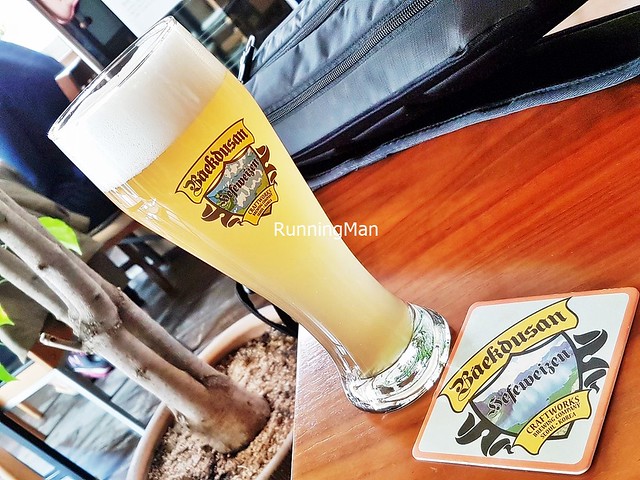 |
| Beer Baekdusan Hefeweizen |
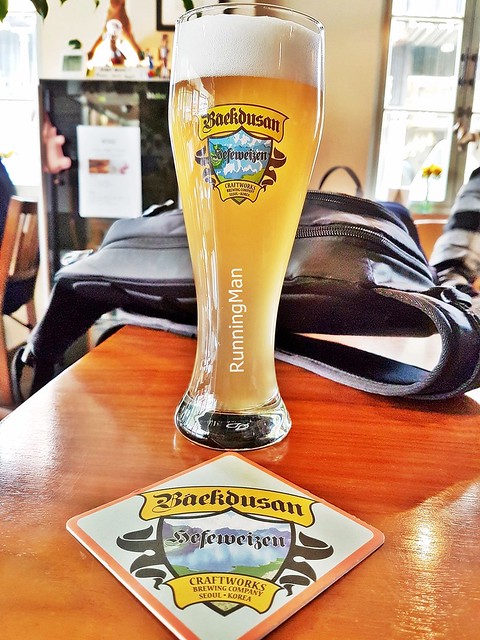 |
| Beer Baekdusan Hefeweizen |
The Beer Cass is a popular South Korean beer, a non-pasteurized lager style beer, brewed by Oriental Brewery in Gangnam district, Seoul, South Korea. It has a bright straw golden colour, with aromas of hay, white rice, corn, and grass. The body is light, crisp, and dry, with moderate amount of carbonation, and tastes of wheat, cornflakes, biscuits, and malt. Has a refreshing grainy sweet flavour, with a dry finish. A popular manner of drinking this is to mix it with plain soju.
 |
| Beer Cass |
The Beer Hite is a common Korean beer, with a bright golden colour, aroma of wheat, cereal, and malt. Body is smooth, crisp, and fizzy, with high amount of carbonation, tastes of bread, barley, malt, and corn, refreshing with some sweetness and bitterness, and undertones of metal.
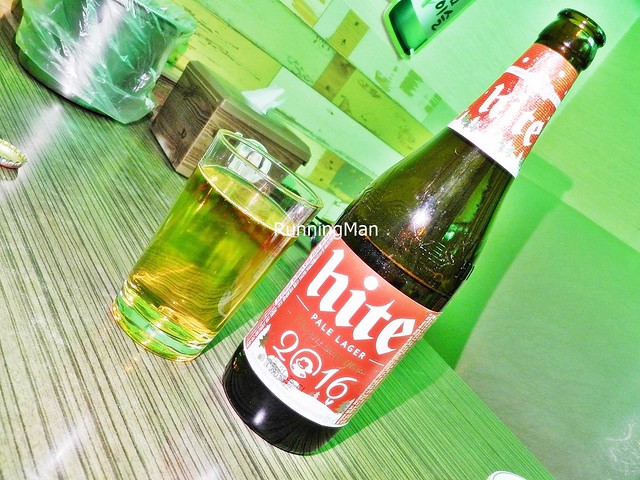 |
| Beer Hite |
The Beer Namsan Pure Pilsner is a Korean craft beer, with a hazy orange amber colour, aroma of malt and grains. Body is medium soft, lively, and crisp, tastes of biscuit, wheat, banana, and malt, starting out sweet, moving on to bitter, then finishing dry and astringent.
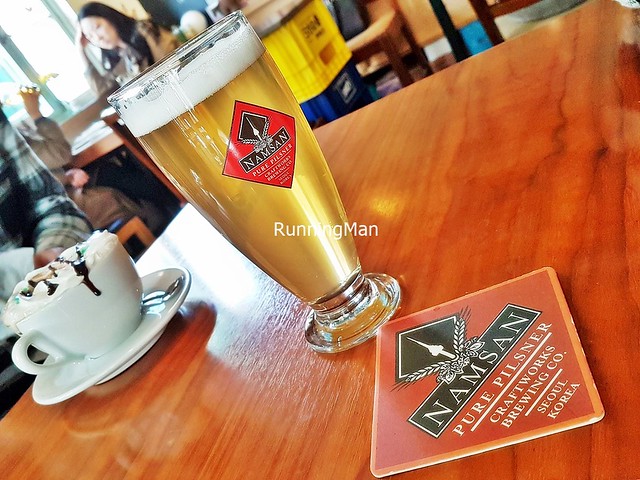 |
| Beer Namsan Pure Pilsner |
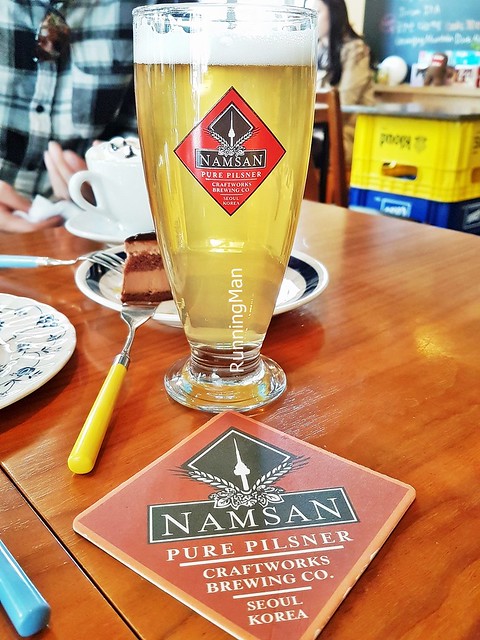 |
| Beer Namsan Pure Pilsner |
The Bibimbap / Mixed Rice is a healthy one-dish main meal, where warm white rice is topped with cucumber, zucchini, daikon radish, mushrooms, spinach, soybean sprouts, doraji / bellflower root, seaweed, gochujang / fermented red chili paste, soy sauce, doenjang / fermented soybean paste, carrots, beef, and a raw egg. Everything (seasonings, rice, vegetables) is stirred together in a large bowl (hence the name), before being eaten. For visual appeal, the ingredients are often placed so adjacent colors complement each other, and the dish is rich in symbolism, with all the different colours having a meaning.
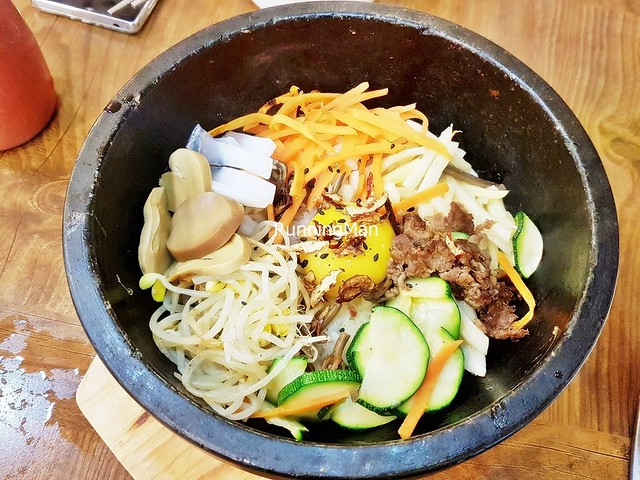 |
| Bibimbap / Mixed Rice |
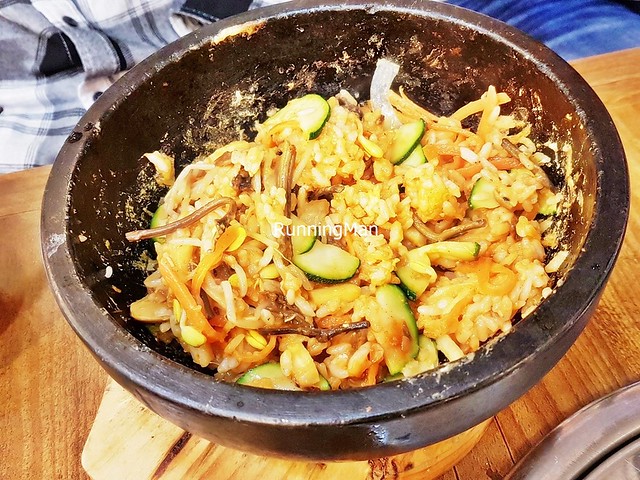 |
| Bibimbap / Mixed Rice |
The Bindaetteok / Mung Bean Pancake, also known as Nokdujeon, is a thick, fluffy, savoury pancake, made with mashed mung beans, scallions, salt, Kimchi Baechu / Kimchi Pickled Cabbage, and fried in sesame oil. This working-person main dish can be eaten throughout the day, though it's more commonly served at breakfast, and is usually accompanied by a dipping sauce made with soy sauce, scallions, vinegar, and chili.
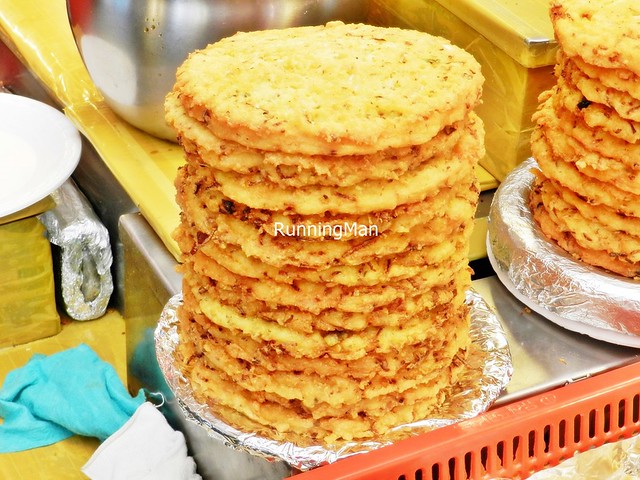 |
| Bindaetteok / Mung Bean Pancake |
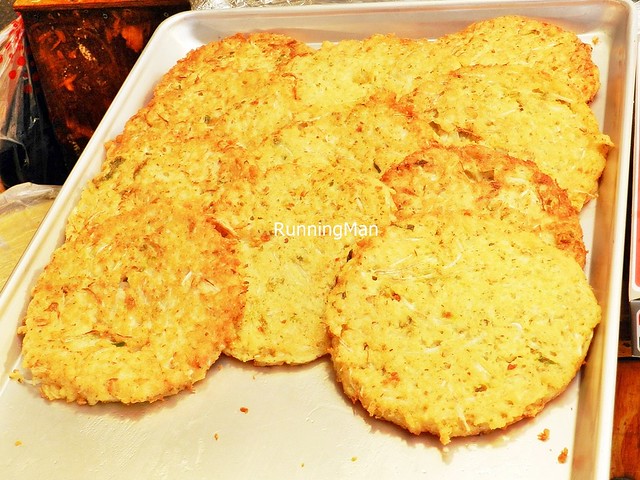 |
| Bindaetteok / Mung Bean Pancake |
The Budae Jjigae / Army Stew originated from scarcity during the Korean War, where people threw whatever food they could find into a large, boiling pot flavoured with gochujang / fermented red chili paste and Kimchi Baechu / Kimchi Pickled Cabbage. This could include ingredients such as hot dogs / sausages, spam / luncheon meat, ground beef, ham, baked beans, instant ramen noodles, onions, scallions, tofu / beancurd, Tteok / Dduk / rice cakes, mushrooms, spinach, cucumbers, zucchini, macaroni, carrots, anchovies, clams, cheese, and more. The resulting savoury spicy soup / broth was satisfiying and filling, a quick one-pot main meal that could be shared by many. Some Koreans also refer to this dish as Johnson-Tang, combining the surname of then American President Lyndon B. Johnson, with Tang, a word meaning soup / broth.
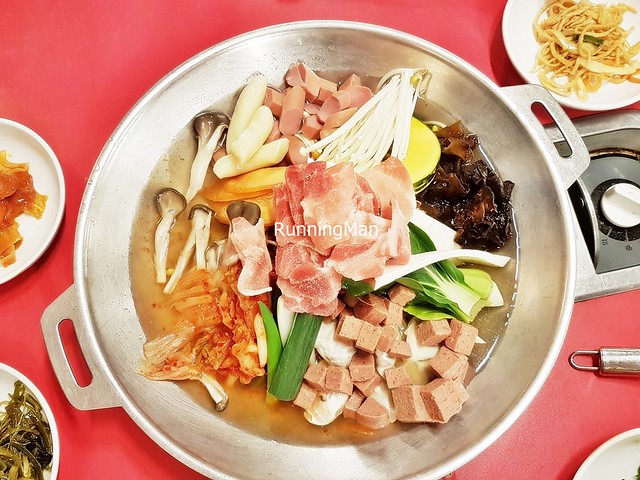 |
| Budae Jjigae / Army Stew |
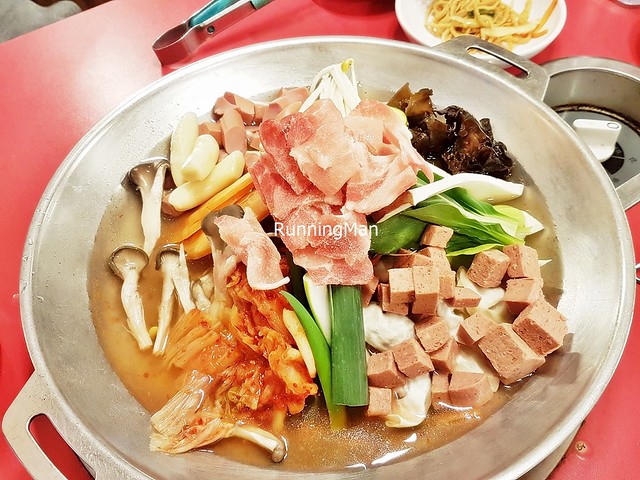 |
| Budae Jjigae / Army Stew |
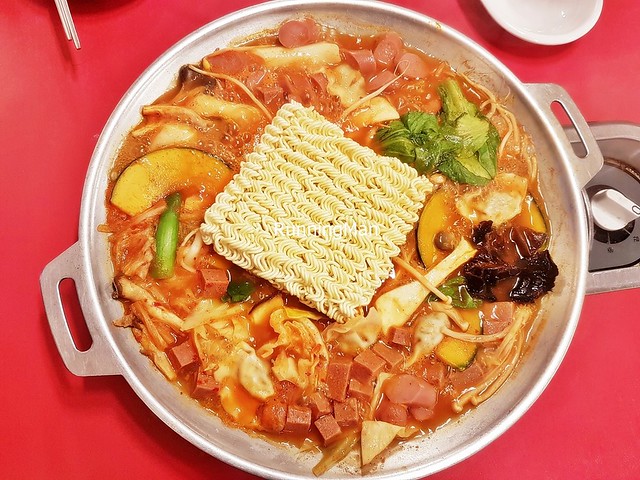 |
| Budae Jjigae / Army Stew |
 |
| Budae Jjigae / Army Stew |
The Bulgogi / Char-Grilled Marinated Beef is a dish of thinly sliced beef sirloin, marinated in soy sauce, garlic, sugar, sesame oil, and pepper, then grilled / sauteed, along with onions, mushrooms, and scallions. It is served as a main dish, and is usually eaten with white rice. Variations include Dweji Bulgogi / Char-Grilled Marinated Pork, Dak Bulgogi / Char-Grilled Marinated Chicken, or Ojingeo Bulgogi / Char-Grilled Marinated Squid.
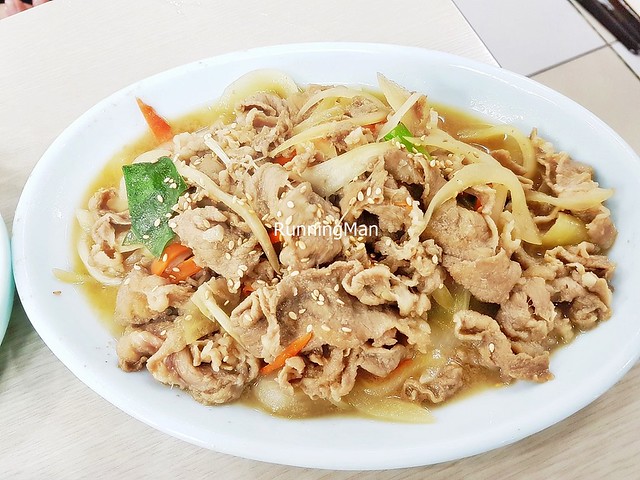 |
| Bulgogi / Char-Grilled Marinated Beef |
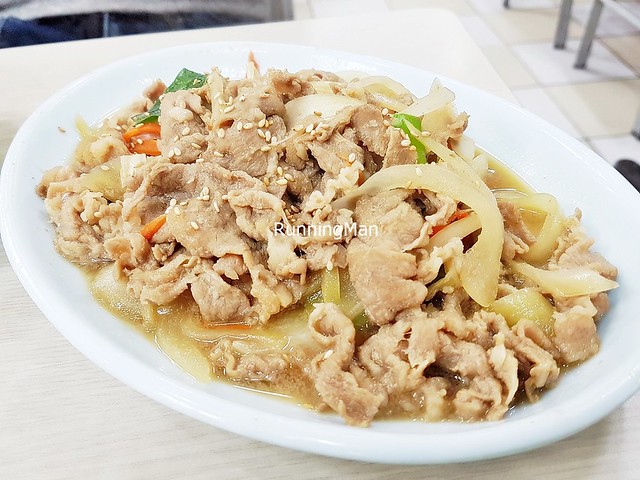 |
| Bulgogi / Char-Grilled Marinated Beef |
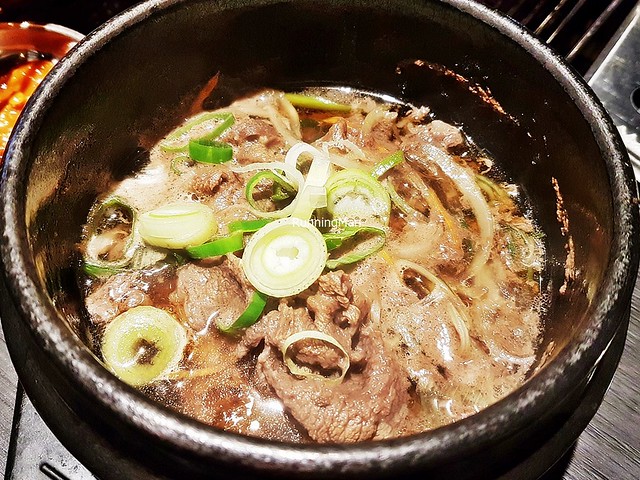 |
| Bulgogi / Char-Grilled Marinated Beef |
 |
| Bulgogi / Char-Grilled Marinated Beef |
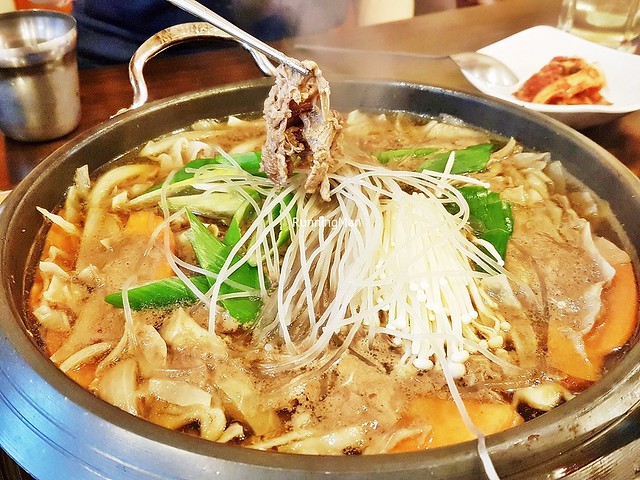 |
| Bulgogi / Char-Grilled Marinated Beef |
The Delimanjoo is a unique South Korea dessert, created in Seoul in 1998. Essentially, it's a warm, soft, round cake made from corn, and filled with a creamy, sweet custard. Moulded in the shape of miniature ears of corn, this sweet dessert treat has gained popularity internationally.
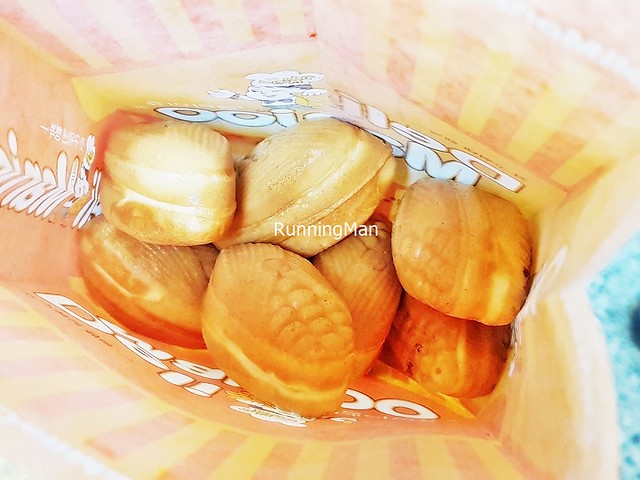 |
| Delimanjoo |
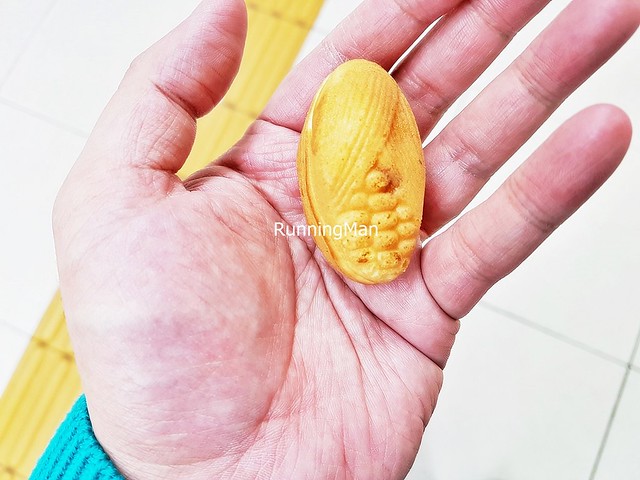 |
| Delimanjoo |
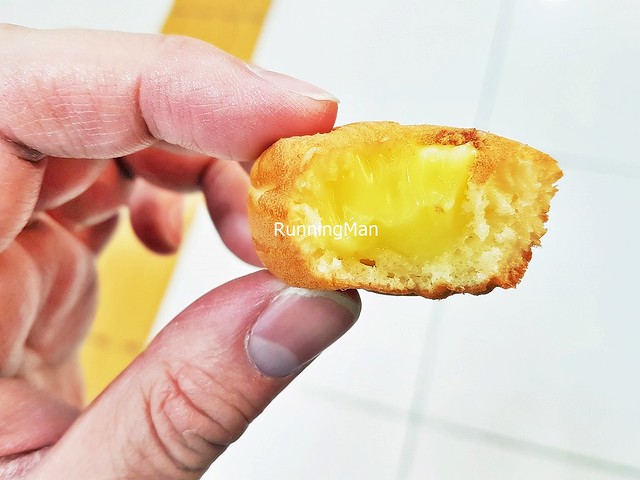 |
| Delimanjoo |
 |
| Delimanjoo |
The Eomuk Guk / Fish Cake Soup is a common working-person main meal, which can be eaten throughout the day. This common street food is made with fish cake, daikon radish, soy sauce, salt, water, anchovies, onions, seaweed, and scallions. The result is a light, clear, thin yet savoury soup / broth, a simple comfort dish. An optional dipping sauce may accompany this dish, and locals also pair this with alcoholic beverages.
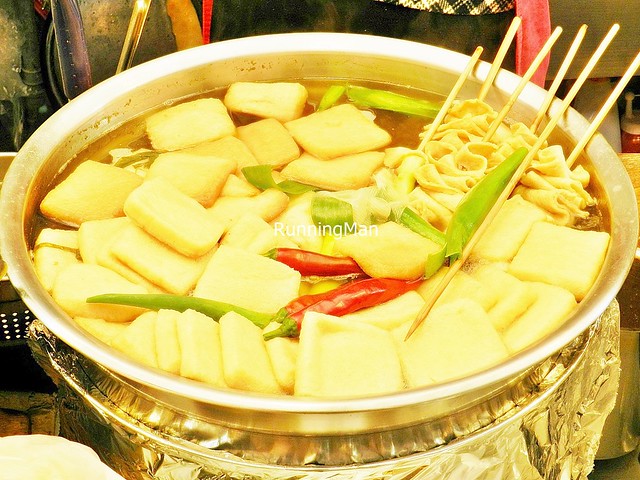 |
| Eomuk Guk / Fish Cake Soup |
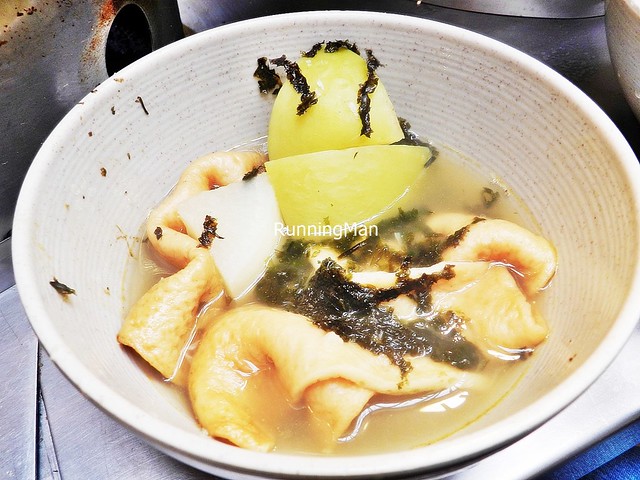 |
| Eomuk Guk / Fish Cake Soup |
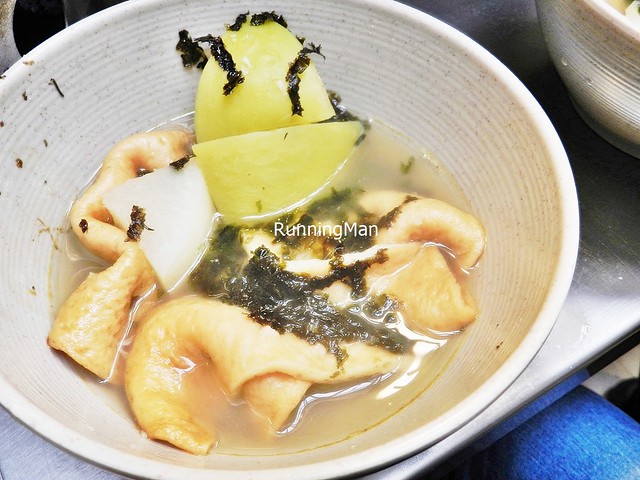 |
| Eomuk Guk / Fish Cake Soup |
The Gimbap / Kimbap / Seaweed Rice Roll is a popular main dish / snack, usually consisting of 1 main ingredient, along with steamed white rice, fried egg, cucumber, carrots, ham, spinach, daikon radish, salt, sugar, sesame seeds, and sesame oil, rolled together in a sheet of seaweed. The Gimbap Sogogi / Seaweed Rice Roll Beef features ground beef, while the Gimbap Chamchi / Seaweed Rice Roll Tuna features tuna mayonnaise, as their respective main ingredient. This dish resembles the Japanese futomaki sushi roll.
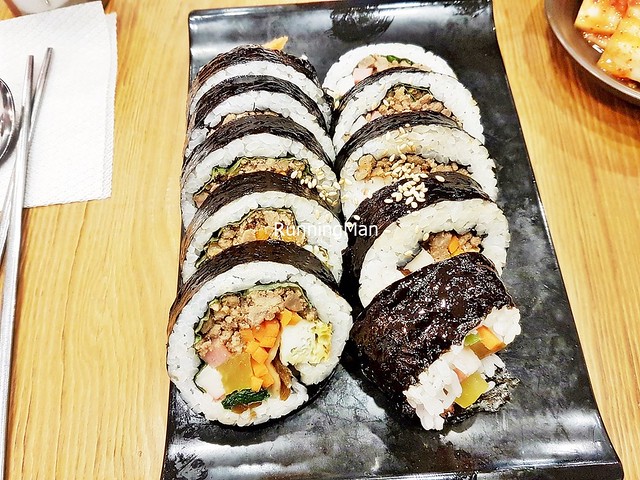 |
| Gimbap Sogogi / Seaweed Rice Roll Beef |
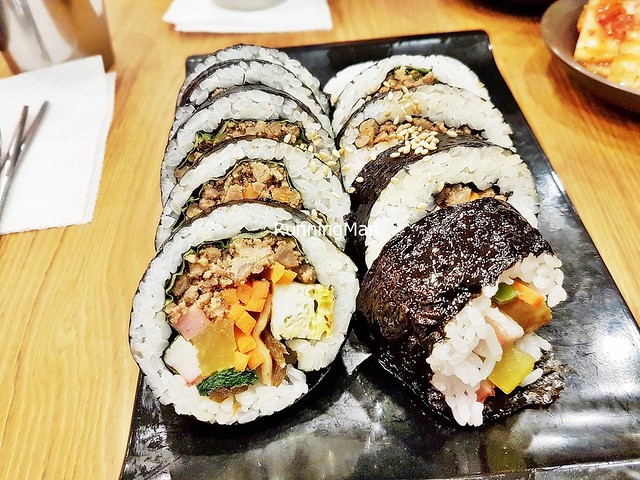 |
| Gimbap Sogogi / Seaweed Rice Roll Beef |
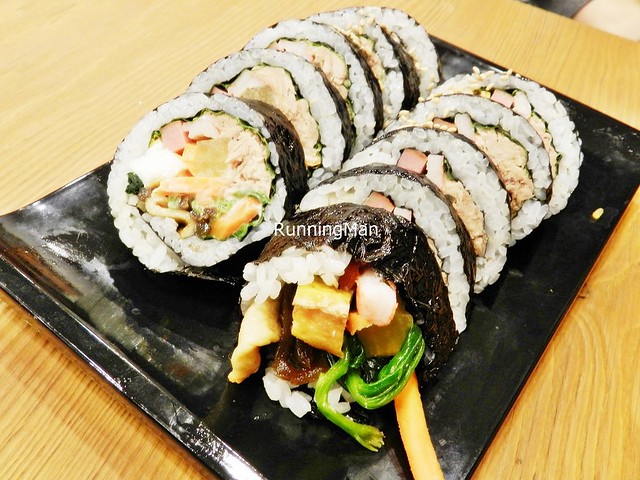 |
| Gimbap Chamchi / Seaweed Rice Roll Tuna |
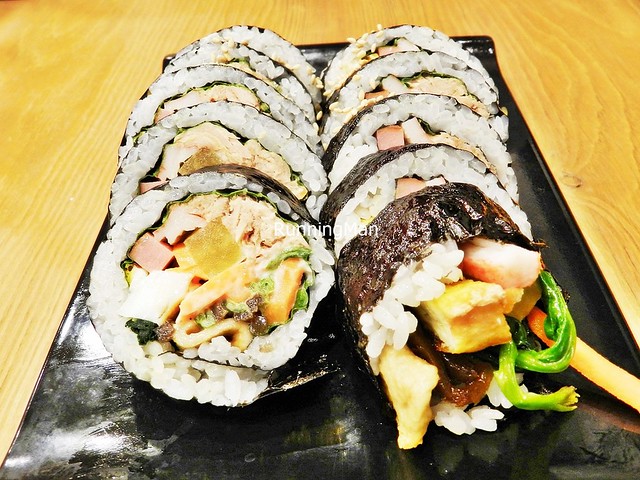 |
| Gimbap Chamchi / Seaweed Rice Roll Tuna |
The Gogigui / Barbecue is not a dish, but rather a dining experience. Diners gather around a charcoal grill built into a table, with a ventilation shaft directly overhead, to roast various types of meat. A typical Gogigui / Barbecue is accompanied by Banchan / side dishes, and a dipping sauce of Ganjang Yangpa Gochu / Soy Sauce With Onions & Chili.
Various types of meat are available, such as Chadolbagi Gui / Grilled Beef Brisket, Deungsim / Beef Sirloin, Jjalbeun Peulleiteu / Beef Short Plate, Kkot Deungsim / Beef Ribeye, Samgyeopsal / Pork Belly, Seukachi Pilles / Pork Scotch Fillet, Teog / Pork Jowl, Hangjeong Sal / Pork Collar, and more. All these meats are usually eaten together with Sangchu / Lettuce, where the meat is wrapped within along with gochujang / fermented red chili paste.
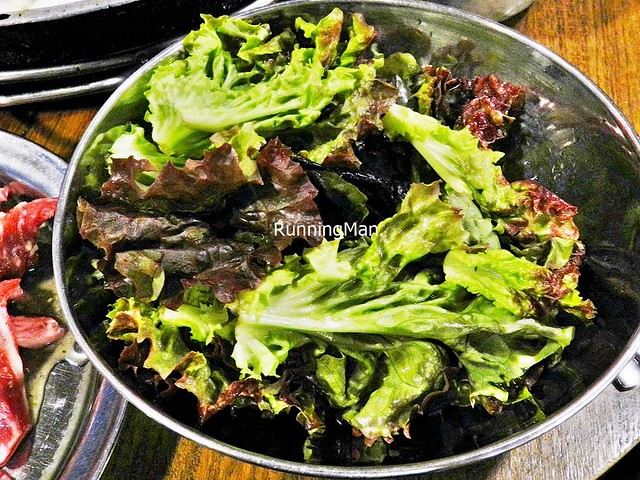 |
| Gogigui / Barbecue - Sangchu / Lettuce |
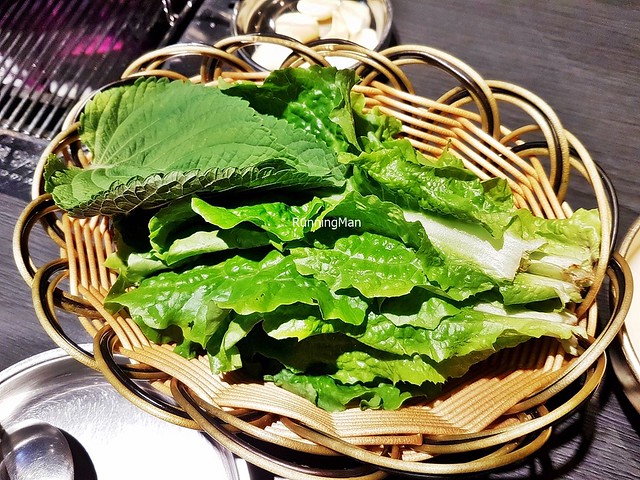 |
| Gogigui / Barbecue - Sangchu / Lettuce |
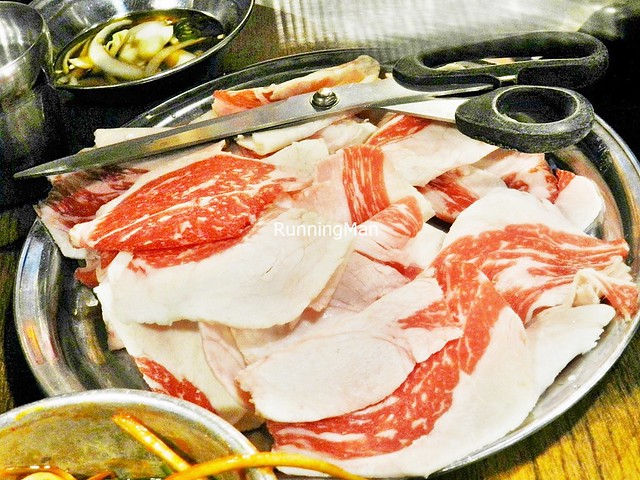 |
| Gogigui / Barbecue - Chadolbagi Gui / Grilled Beef Brisket |
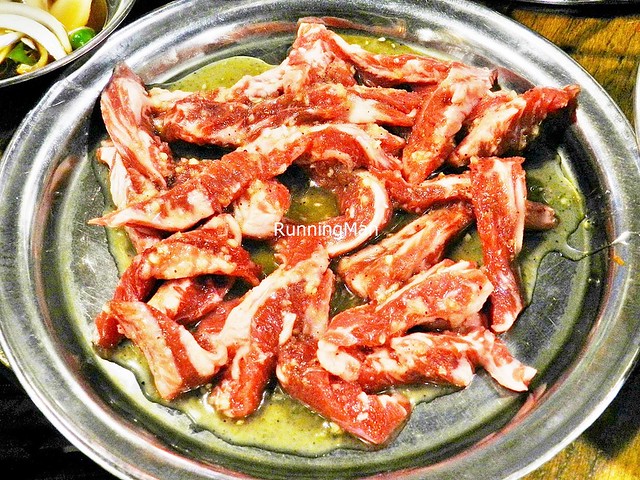 |
| Gogigui / Barbecue - Deungsim / Beef Sirloin |
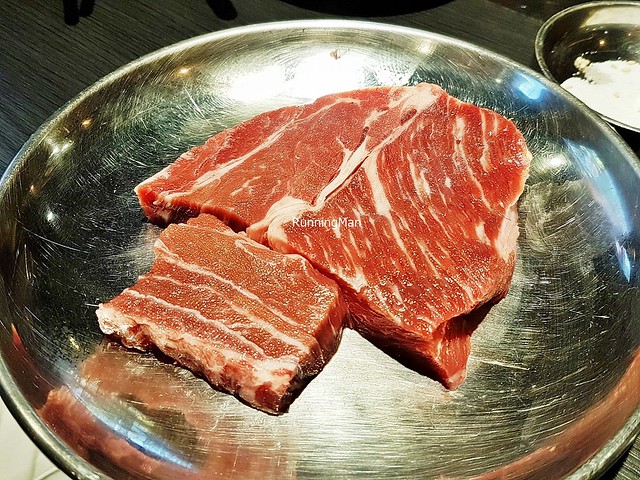 |
| Gogigui / Barbecue - Deungsim / Beef Sirloin |
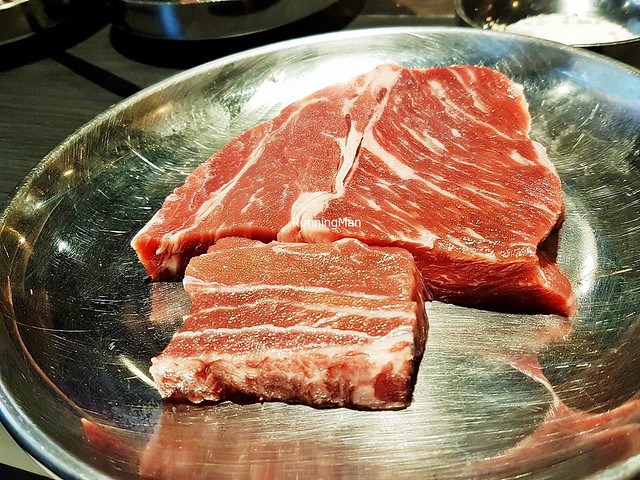 |
| Gogigui / Barbecue - Deungsim / Beef Sirloin |
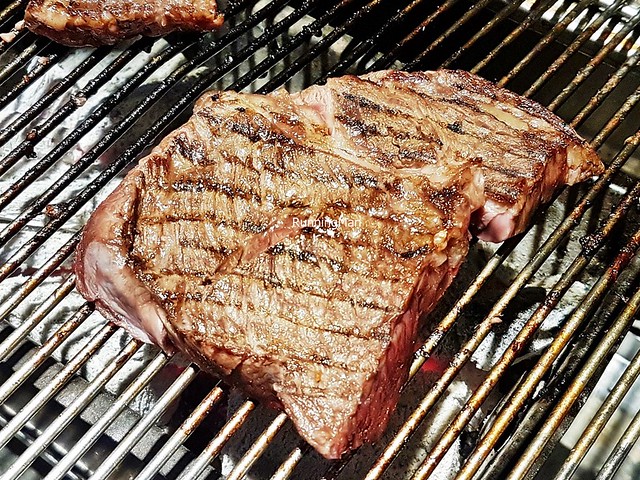 |
| Gogigui / Barbecue - Deungsim / Beef Sirloin |
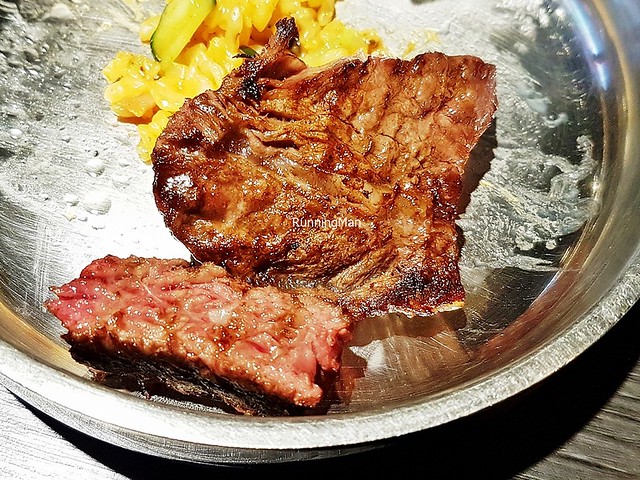 |
| Gogigui / Barbecue - Deungsim / Beef Sirloin |
 |
| Gogigui / Barbecue - Deungsim / Beef Sirloin |
 |
| Gogigui / Barbecue - Deungsim / Beef Sirloin |
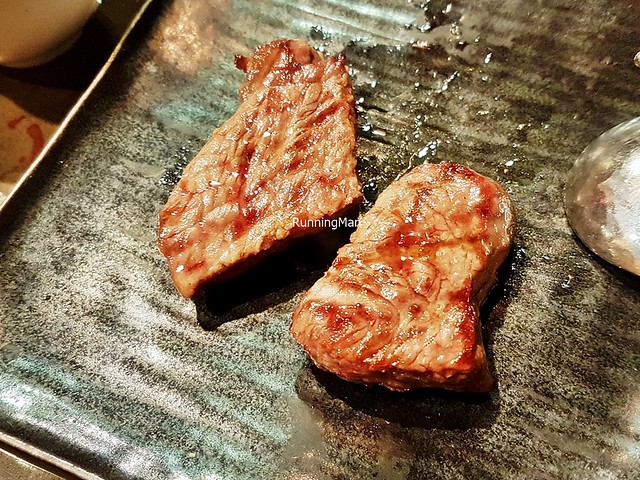 |
| Gogigui / Barbecue - Deungsim / Beef Sirloin |
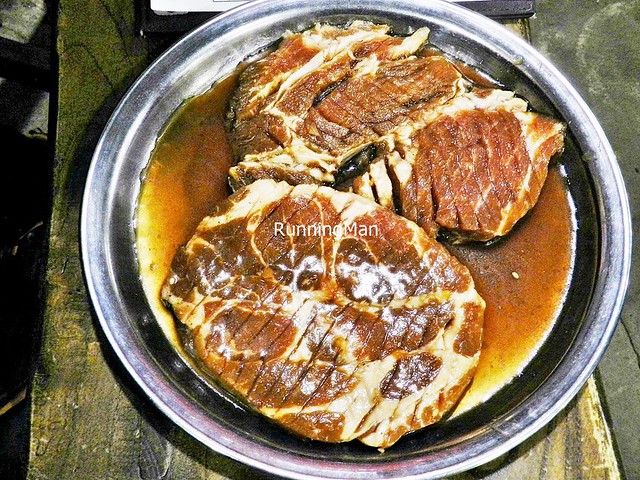 |
| Gogigui / Barbecue - Kkot Deungsim / Beef Ribeye |
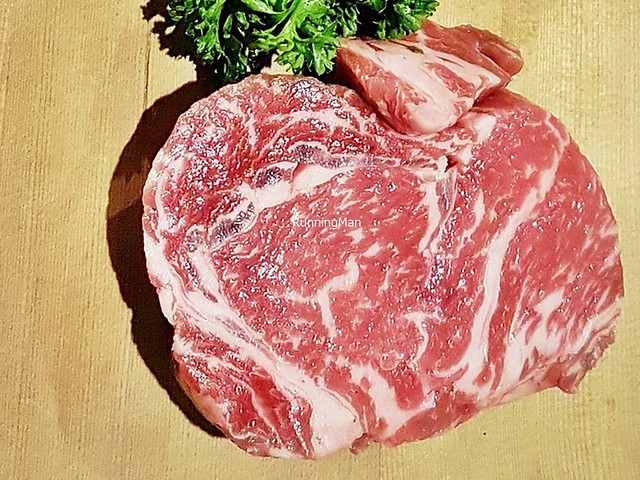 |
| Gogigui / Barbecue - Kkot Deungsim / Beef Ribeye |
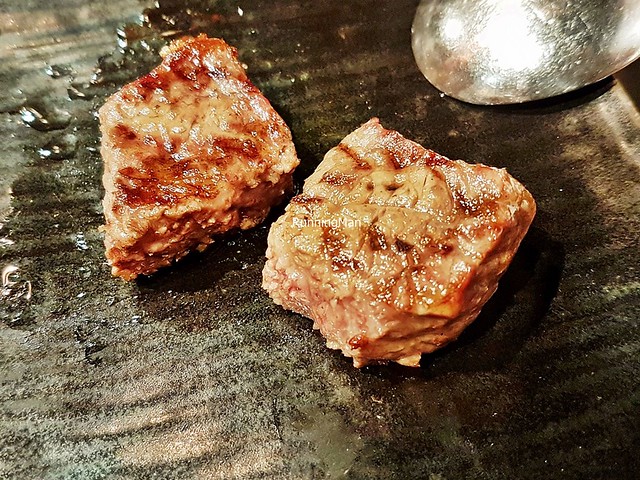 |
| Gogigui / Barbecue - Kkot Deungsim / Beef Ribeye |
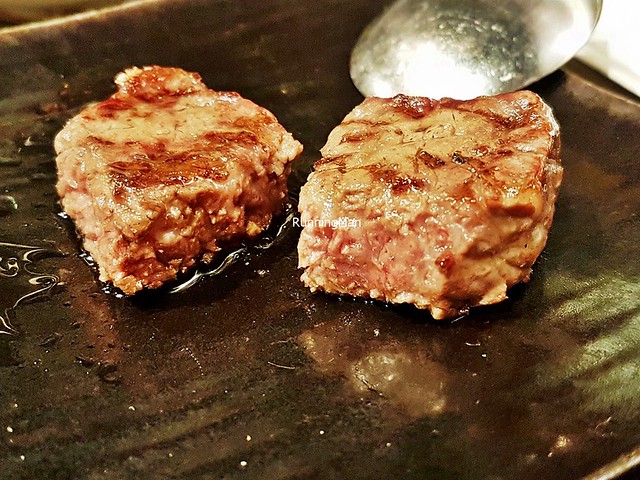 |
| Gogigui / Barbecue - Kkot Deungsim / Beef Ribeye |
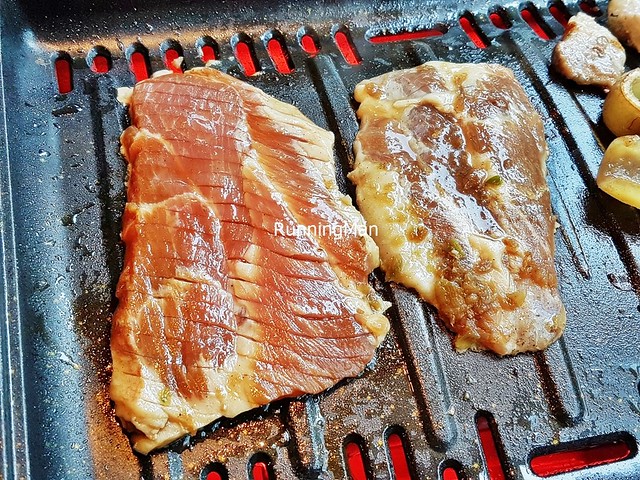 |
| Gogigui / Barbecue - Jjalbeun Peulleiteu / Beef Short Plate |
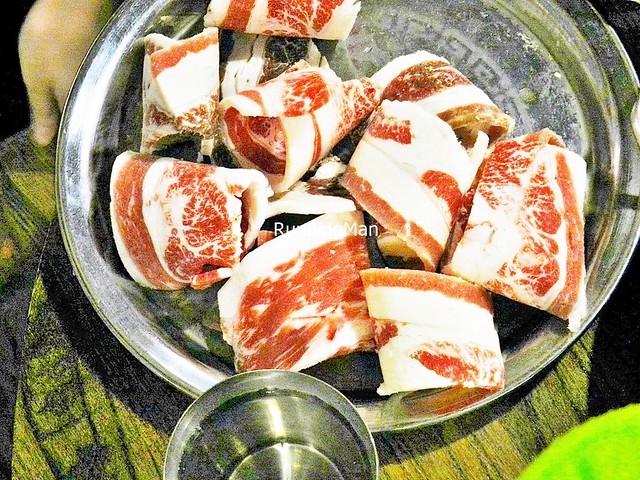 |
| Samgyeopsal / Pork Belly |
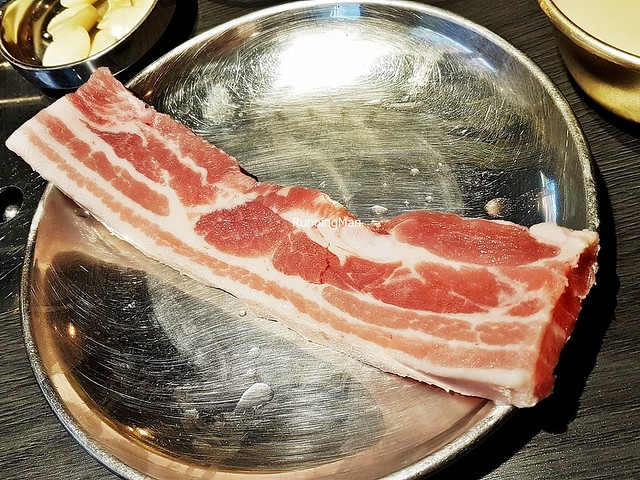 |
| Samgyeopsal / Pork Belly |
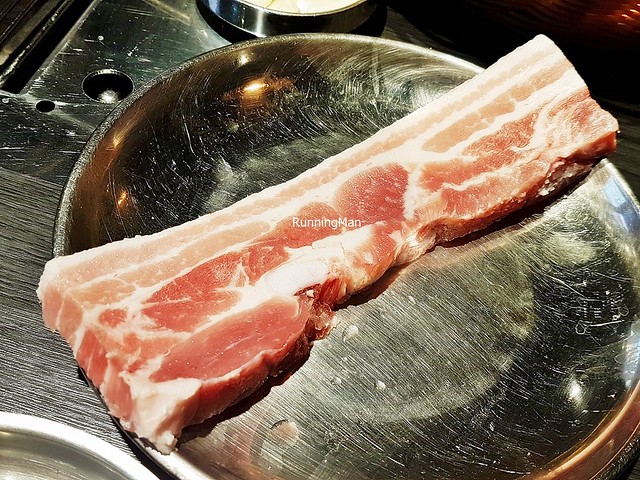 |
| Samgyeopsal / Pork Belly |
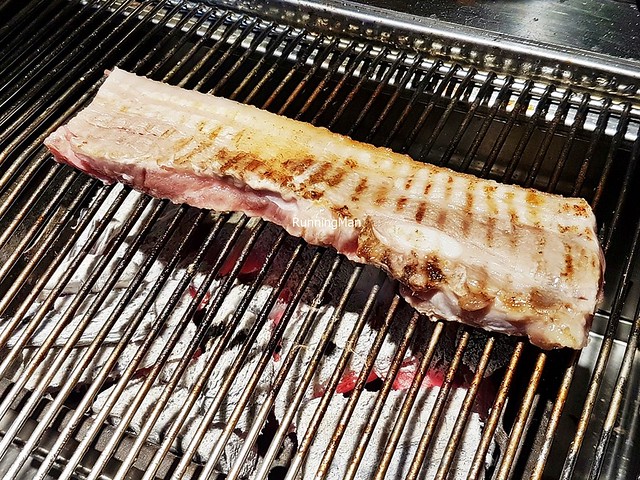 |
| Samgyeopsal Gui / Grilled Pork Belly |
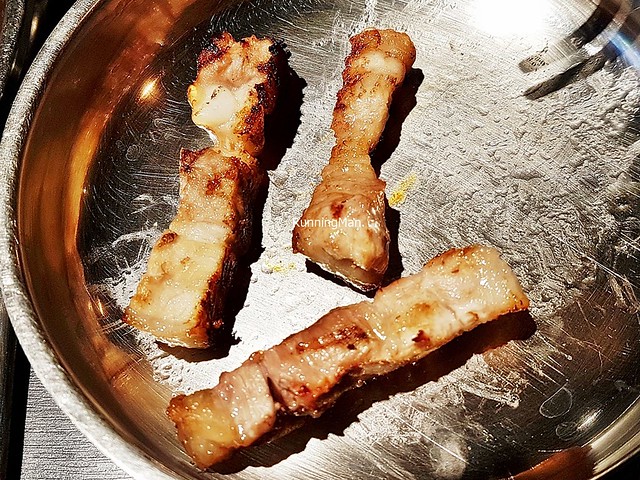 |
| Samgyeopsal Gui / Grilled Pork Belly |
 |
| Samgyeopsal / Pork Belly |
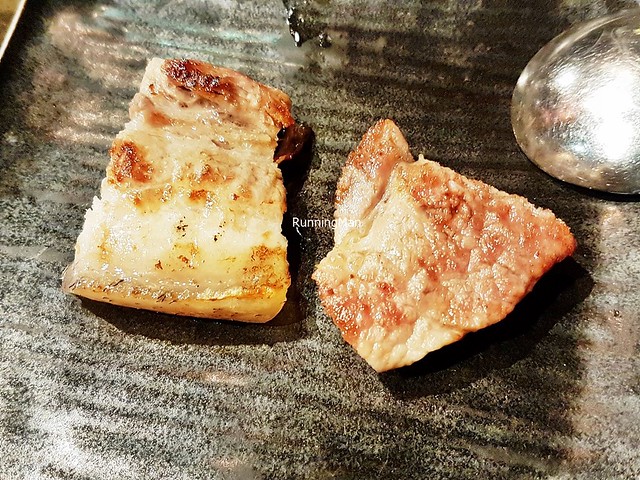 |
| Samgyeopsal Gui / Grilled Pork Belly |
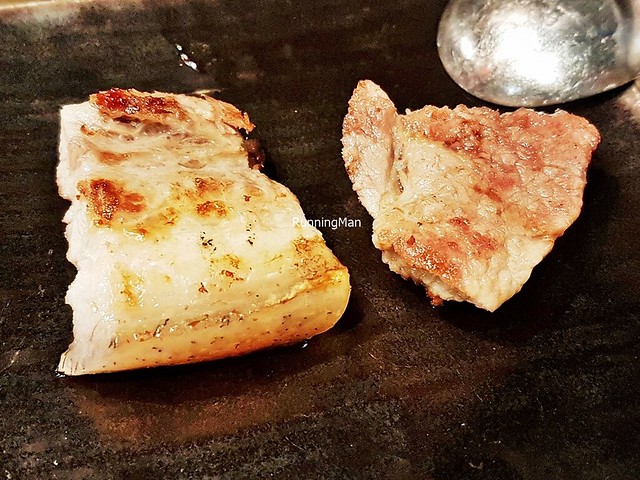 |
| Samgyeopsal Gui / Grilled Pork Belly |
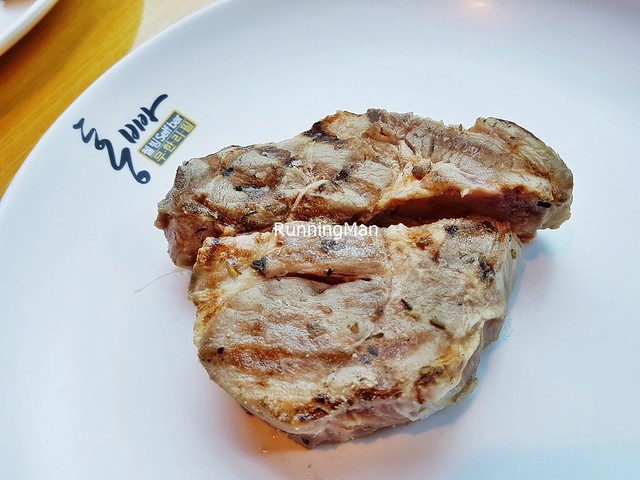 |
| Gogigui / Barbecue - Seukachi Pilles / Pork Scotch Fillet |
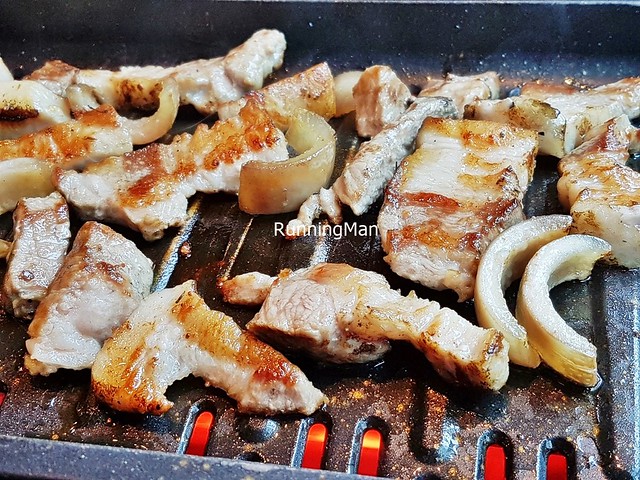 |
| Gogigui / Barbecue - Teog / Pork Jowl |
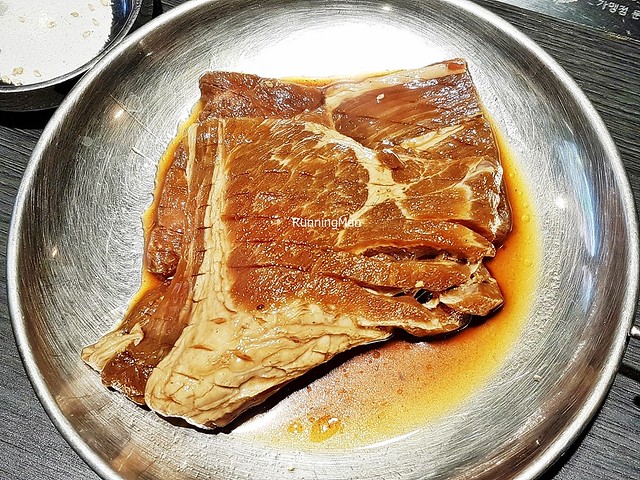 |
| Gogigui / Barbecue - Teog / Pork Jowl |
 |
| Gogigui / Barbecue - Teog / Pork Jowl |
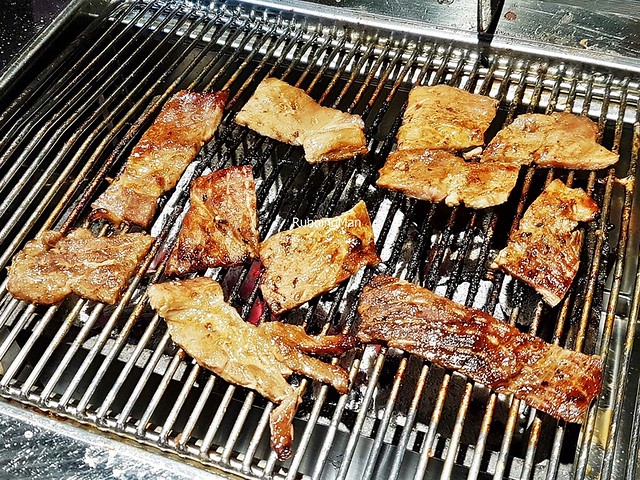 |
| Gogigui / Barbecue - Teog / Pork Jowl |
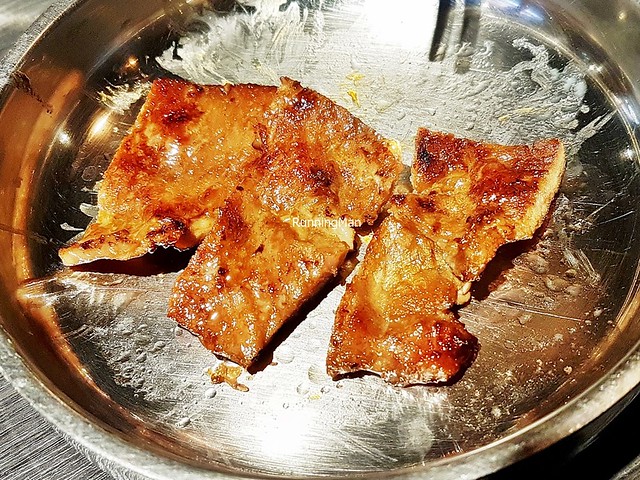 |
| Gogigui / Barbecue - Teog / Pork Jowl |
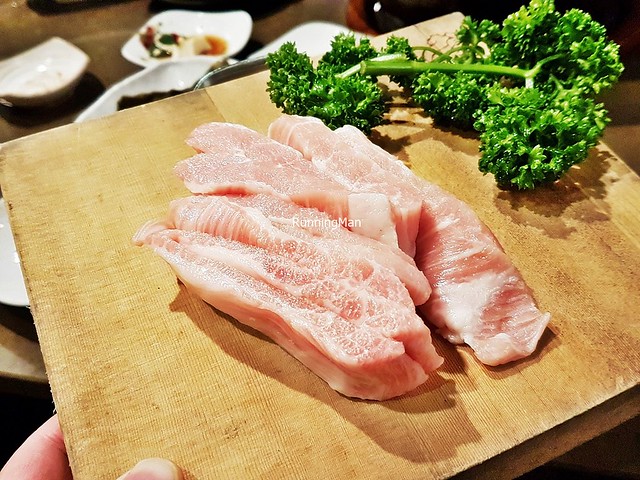 |
| Gogigui / Barbecue - Teog / Pork Jowl |
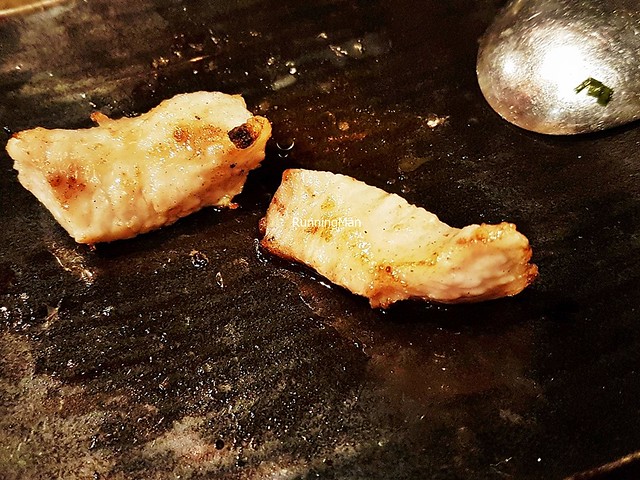 |
| Gogigui / Barbecue - Teog / Pork Jowl |
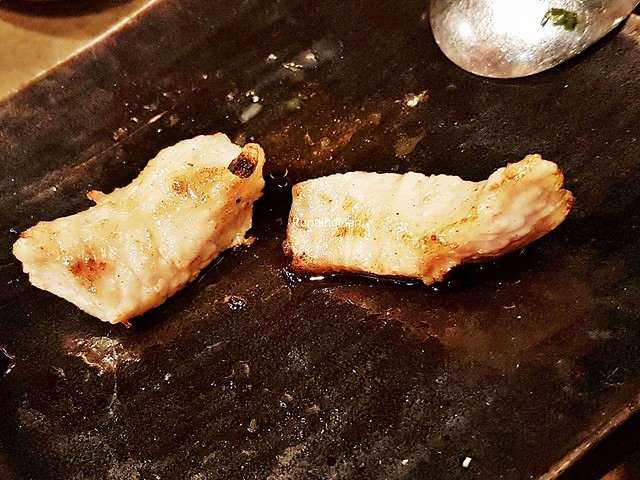 |
| Gogigui / Barbecue - Teog / Pork Jowl |
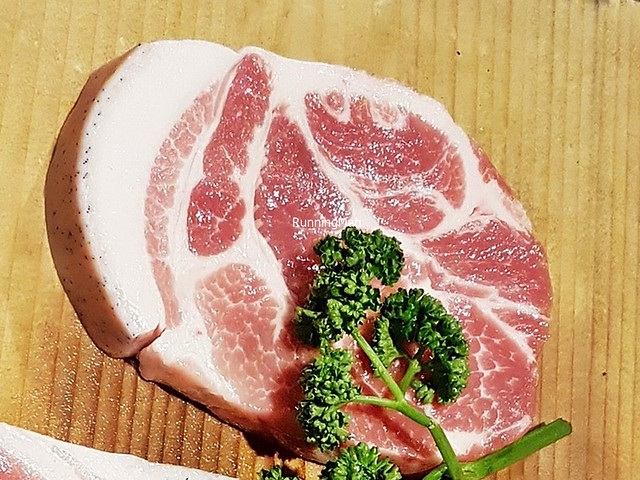 |
| Gogigui / Barbecue - Hangjeong Sal / Pork Collar |
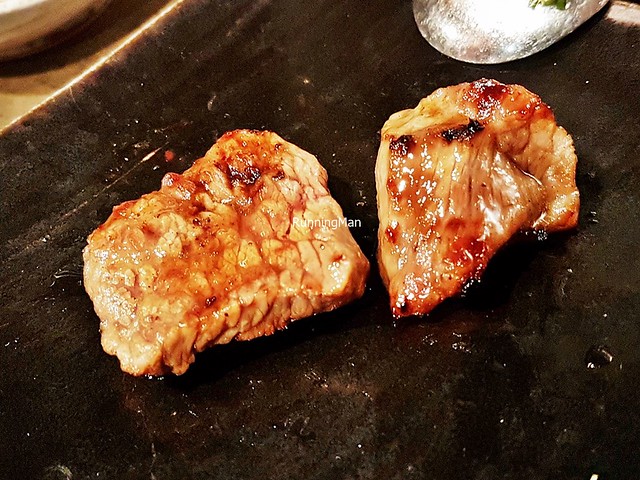 |
| Gogigui / Barbecue - Hangjeong Sal / Pork Collar |
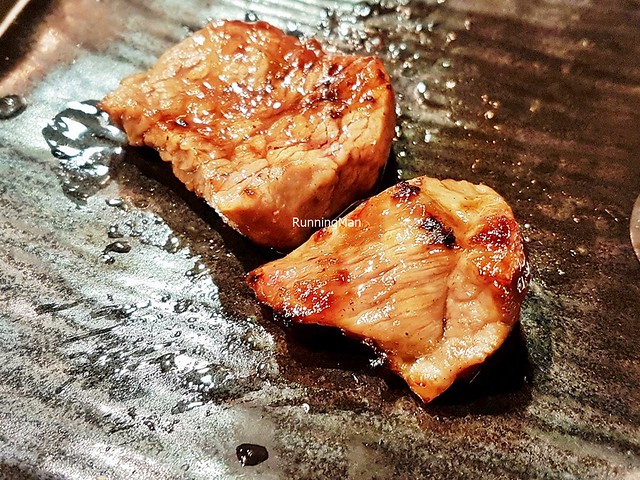 |
| Gogigui / Barbecue - Hangjeong Sal / Pork Collar |
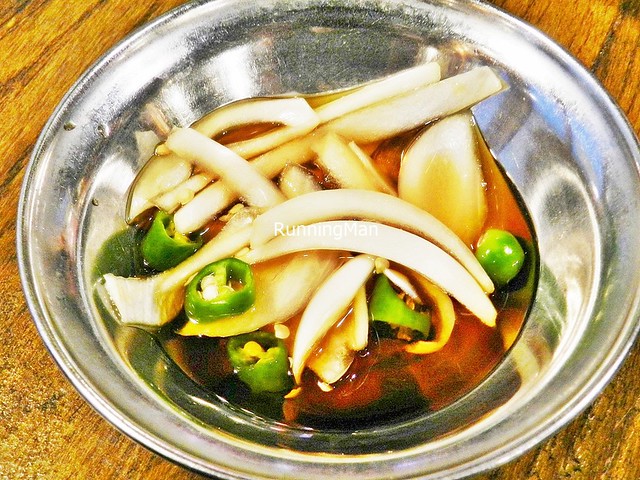 |
| Gogigui / Barbecue - Ganjang Yangpa Gochu / Soy Sauce With Onions & Chili |
The Gyeran Bbang / Egg Bread is a popular street food snack, commonly found throughout Seoul, South Korea. It's made with whole milk, vinegar, all-purpose flour, baking soda, baking powder, salt, sugar, butter, eggs, and topped with grated mozzarella cheese and parsley. This baked snack is sweet, fluffy, and cheap, a cute little loaf of bread with a whole egg inside, served by street vendors in a cardboard paper sleeve.
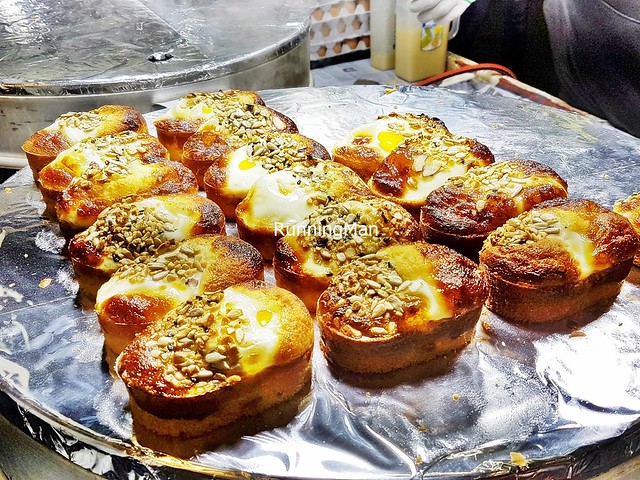 |
| Gyeran Bbang / Egg Bread |
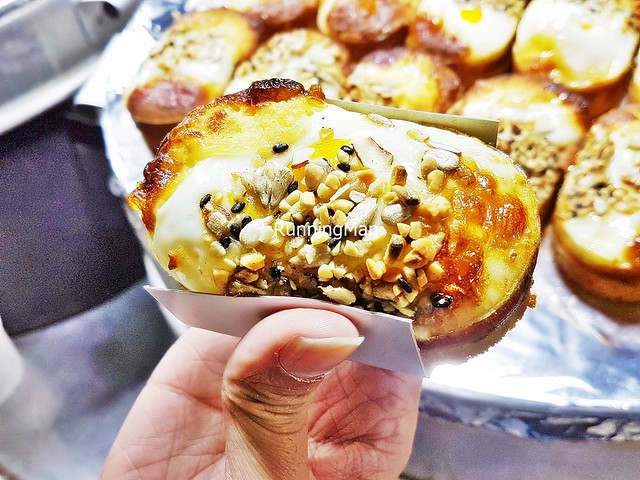 |
| Gyeran Bbang / Egg Bread |
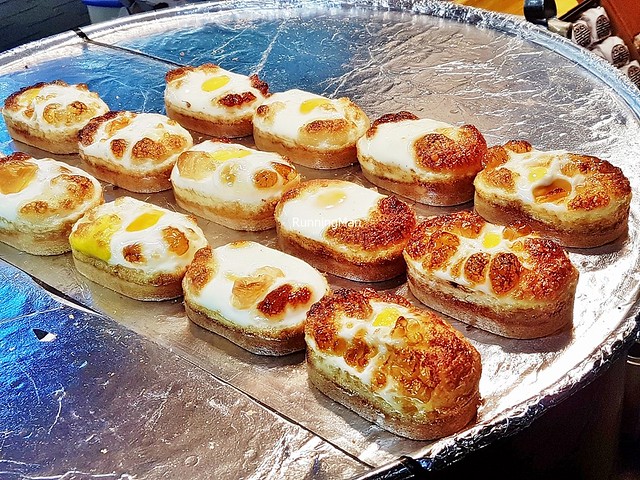 |
| Gyeran Bbang / Egg Bread |
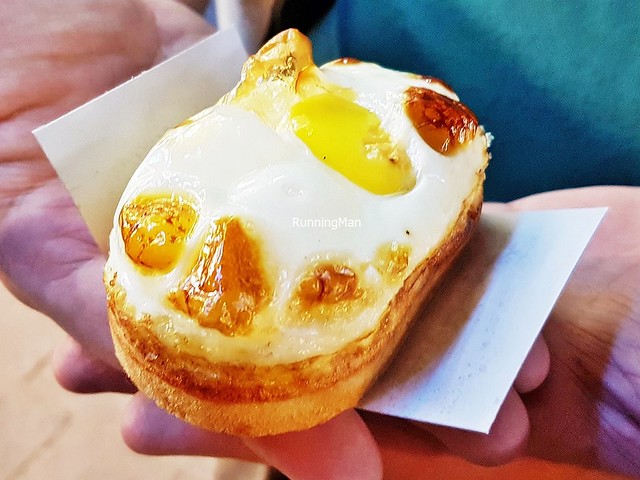 |
| Gyeran Bbang / Egg Bread |
The Haemul Pajeon / Seafood Pancake is a thin pancake, topped with a variety of fresh seafood, such as squid, octopus, clams, or shrimp / prawns. The batter for the pancake itself can be made from either all-purpose flour, buckwheat, egg, or mashed mung beans. Usually served as a Banchan / side dish, and eaten with a dipping sauce made from soy sauce, vinegar, scallions, and chili.
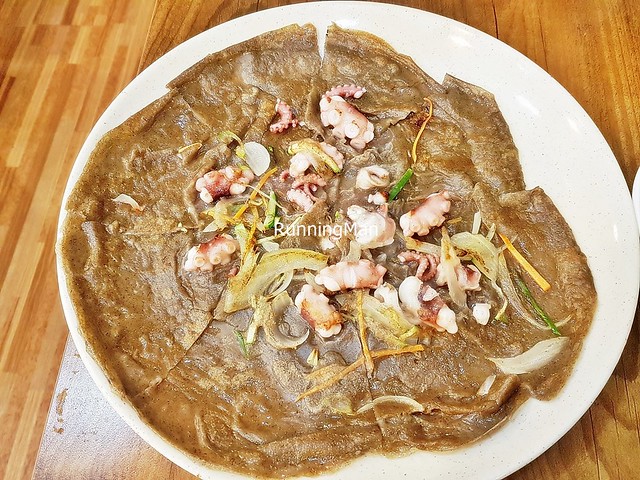 |
| Haemul Pajeon / Seafood Pancake |
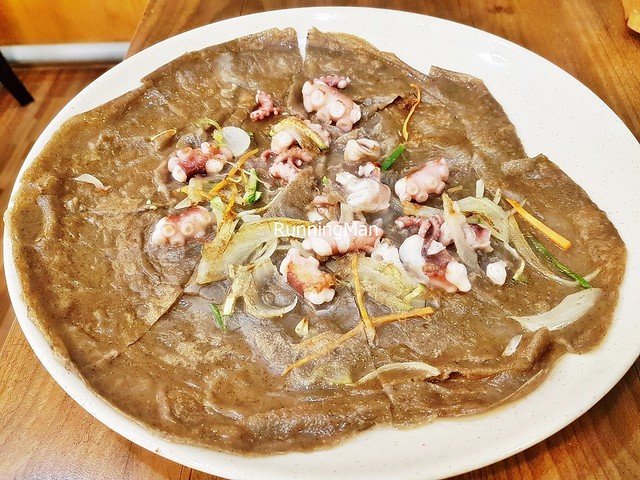 |
| Haemul Pajeon / Seafood Pancake |
 |
| Haemul Pajeon / Seafood Pancake |
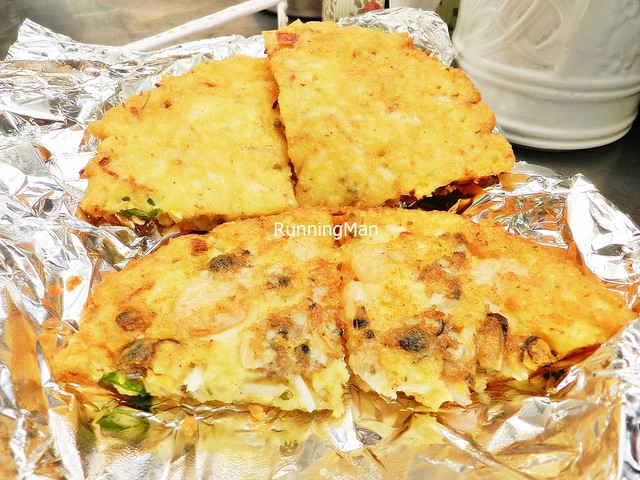 |
| Haemul Pajeon / Seafood Pancake |
A popular Korean Chinese fusion dish, the Jajangmyeon / Black Bean Sauce Noodles features a base of thick chewy wheat flour noodles, coated in a thick gloopy gravy made from fermented wheat flour, soy bean flour, water, and oyster sauce. Despite the name, actual black beans are rarely used, and the gravy carries a distinct sweet savoury earthy salty flavour. Garnishes typically include tender minced pork with meaty savoury salty flavour, juicy cucumber strips with vegetal sweet flavour, crisp white onions with vegetal sweet sour flavour, and a bouncy boiled egg with eggy sweet flavour. Other ingredients may also be added, including prawns, squid, aehobak / zucchini, cabbage, and toasted sesame seeds.
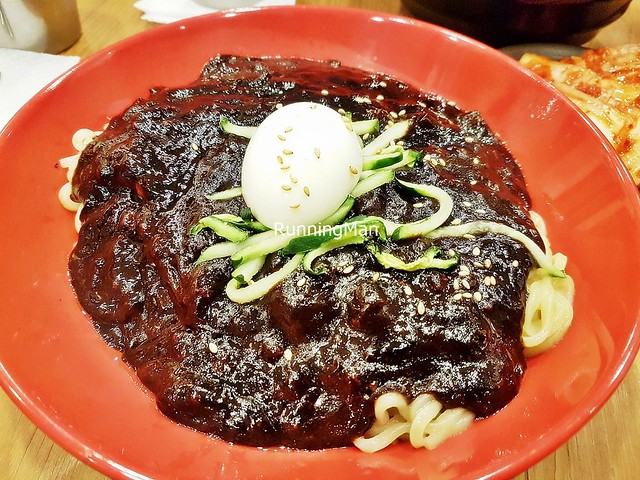 |
| Jajangmyeon / Black Bean Sauce Noodles |
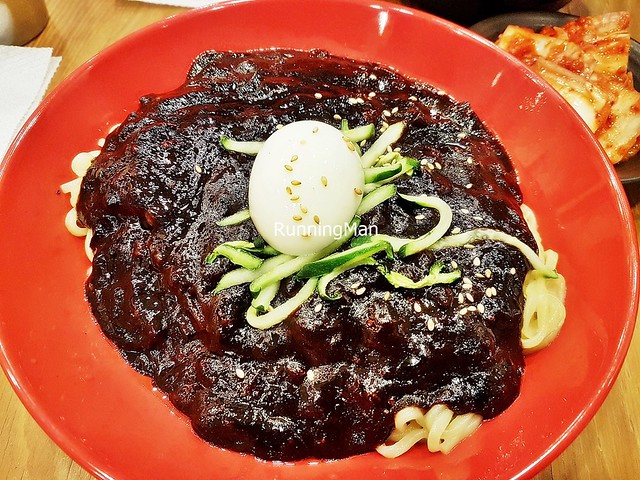 |
| Jajangmyeon / Black Bean Sauce Noodles |
Considered among the world's healthiest foods, and said to even prevent stomach cancer, Kimchi Baechu / Kimchi Pickled Cabbage is more than just a tasty Banchan / side dish, but is also a versatile ingredient incorporated into many Korean dishes. It's made with napa cabbage rubbed with sea salt; seasoned with a paste made from scallions, ginger, daikon radish, garlic, glutinous rice, saeujeot / fermented shrimp sauce, aekjeot / fish sauce, eoriguljeot / oyster sauce, and chili; then left to ferment in a brine of vinegar and water. The most iconic national dish of South Korea, this is commonly served at every meal in Seoul, and has a sour, sharp taste, with a crunchy texture.
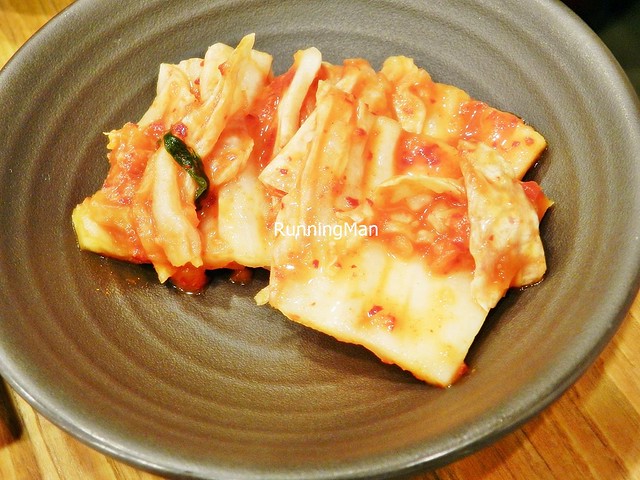 |
| Kimchi Baechu / Kimchi Pickled Cabbage |
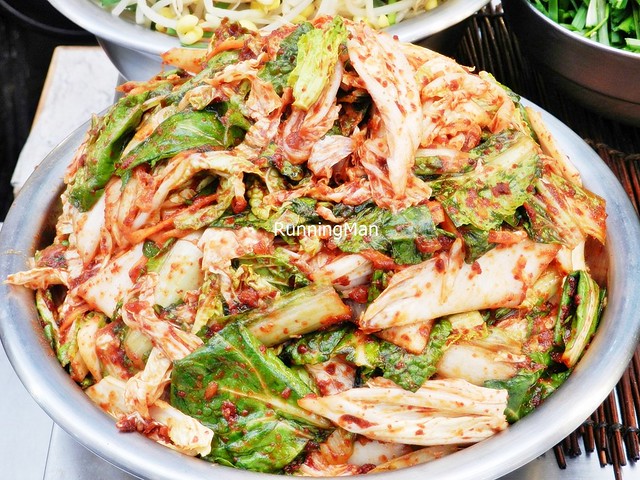 |
| Kimchi Baechu / Kimchi Pickled Cabbage |
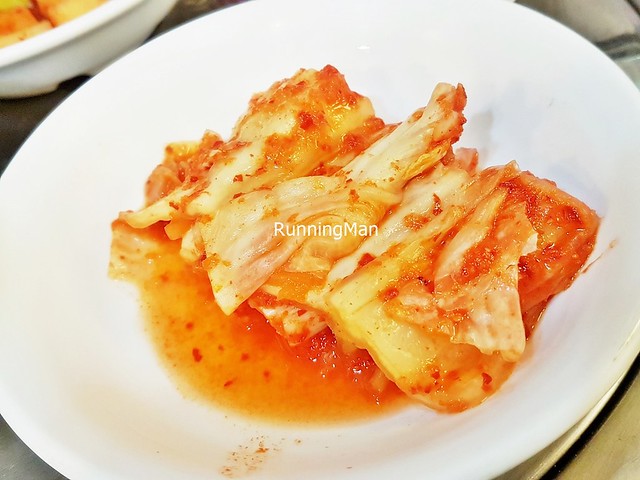 |
| Kimchi Baechu / Kimchi Pickled Cabbage |
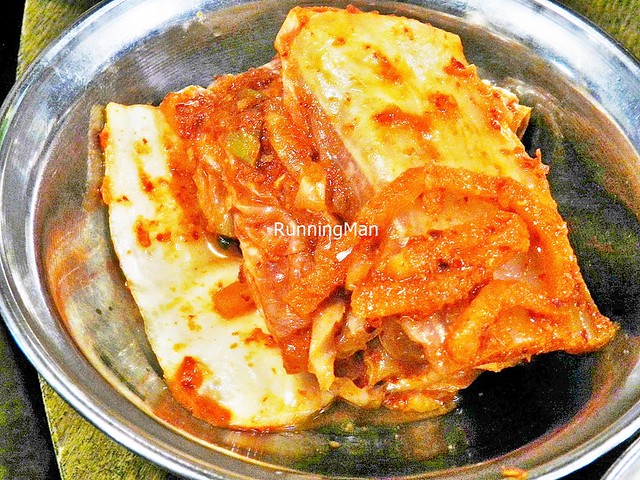 |
| Kimchi Baechu / Kimchi Pickled Cabbage |
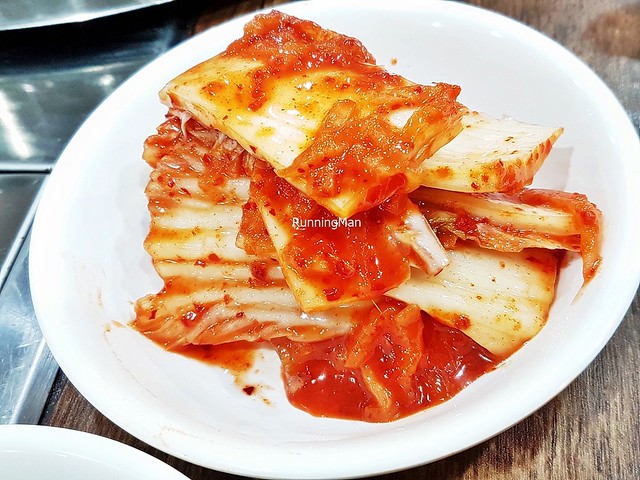 |
| Kimchi Baechu / Kimchi Pickled Cabbage |
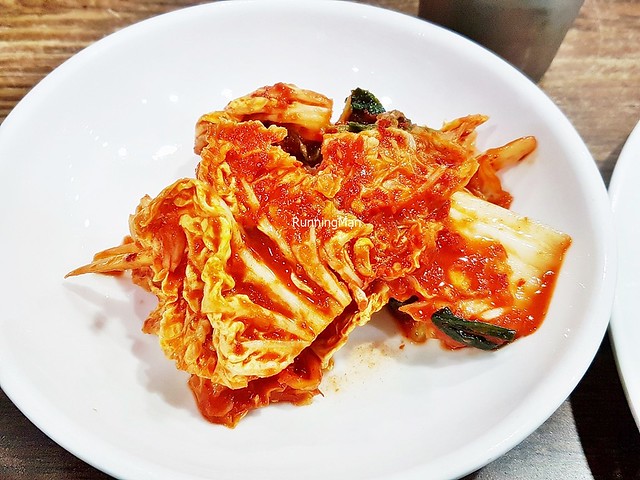 |
| Kimchi Baechu / Kimchi Pickled Cabbage |
Trailing just behind in popularity is another variation of Kimchi, the Kimchi Oi Sobaegi / Kimchi Pickled Cucumber, also served as a Banchan / side dish. While essentially all the same seasonings, ingredients, and preparation methods are used, this simply replaces the napa cabbage with cucumbers instead. It has that same sour, sharp taste, with a crunchy texture.
 |
| Kimchi Oi Sobaegi / Kimchi Pickled Cucumber |
The Kkakdugi / Pickled Daikon Radish and Kimchi Kkakdugi / Kimchi Pickled Daikon Radish are banchan / side dishes that are typically consumed chilled, and have a sharp sour sweet vegetal flavour with a crisp crunchy texture. The daikon radish is usually brined in white vinegar, paired with full-flavoured or fried food such as fried chicken. It helps to refresh the palate as part of the meal.
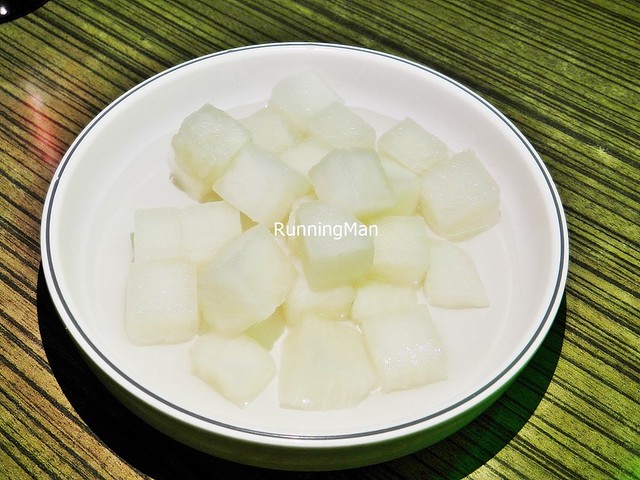 |
| Kkakdugi / Pickled Daikon Radish |
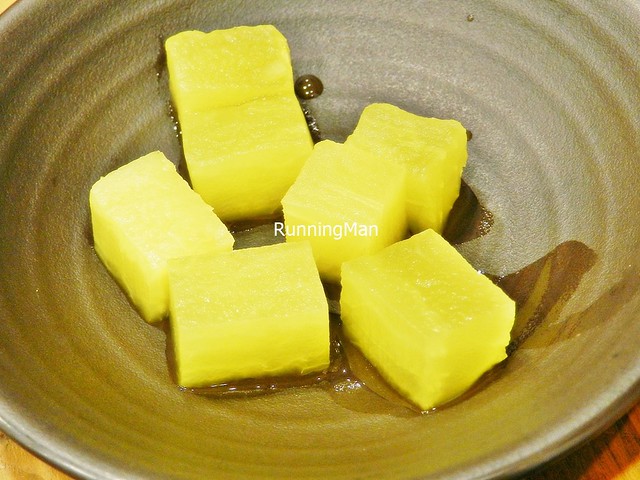 |
| Kkakdugi / Pickled Daikon Radish |
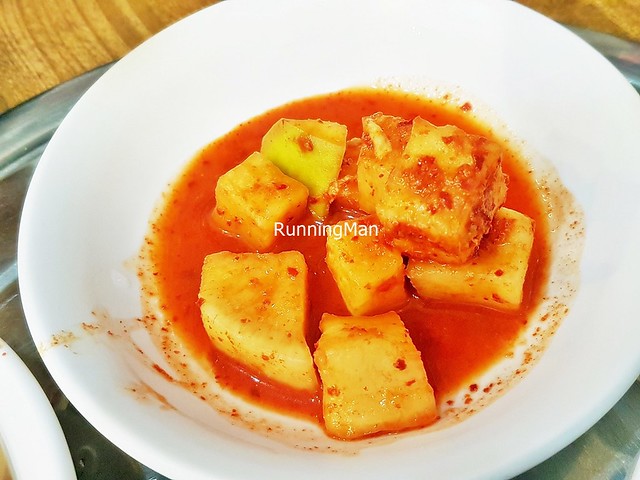 |
| Kimchi Kkakdugi / Kimchi Pickled Daikon Radish |
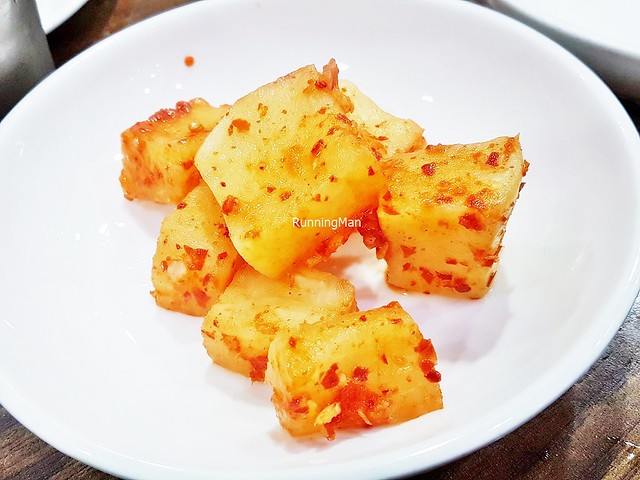 |
| Kimchi Kkakdugi / Kimchi Pickled Daikon Radish |
The Eomuk Bokkeum / Stir-Fried Fish Cake is a common Banchan / side dish which features fish cakes stir-fried with onions, soy sauce, garlic, salt, carrots, spinach, and sesame seeds. This simple savoury dish is commonly eaten along with white rice.
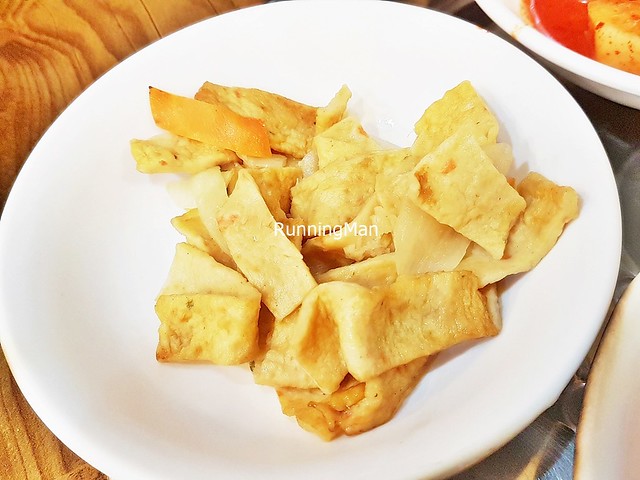 |
| Eomuk Bokkeum / Stir-Fried Fish Cake |
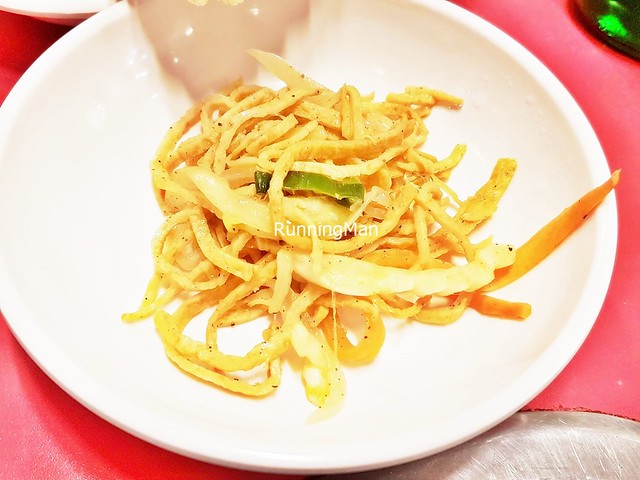 |
| Eomuk Bokkeum / Stir-Fried Fish Cake |
Another common Banchan / side dish, the Kongnamul / Cold Soy Bean Sprouts is a chilled sweet savoury dish, featuring soybean sprouts boiled with salt, garlic, aekjeot / fish sauce, then garnished with sesame seeds. Sometimes, chili is added. This is eaten along with white rice.
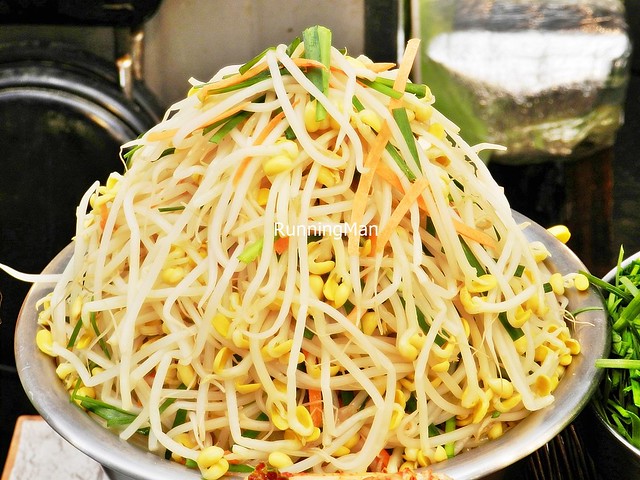 |
| Kongnamul / Cold Soy Bean Sprouts |
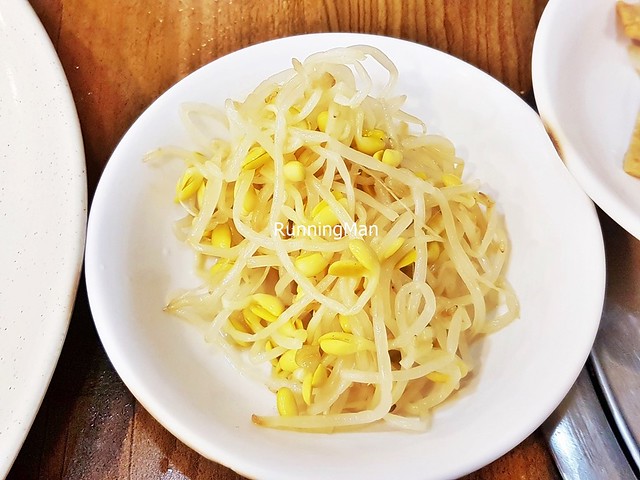 |
| Kongnamul / Cold Soy Bean Sprouts |
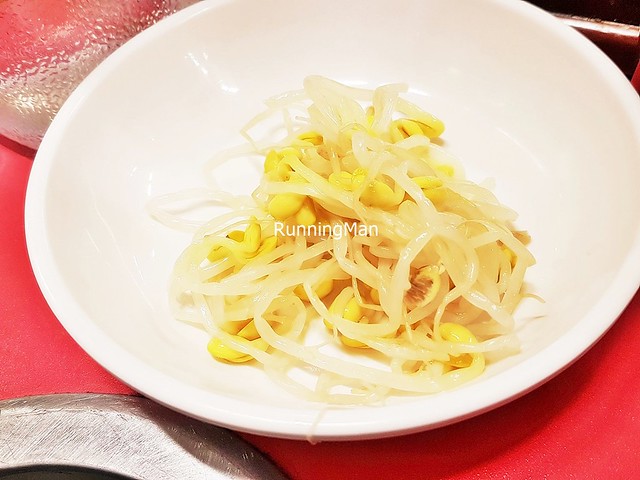 |
| Kongnamul / Cold Soy Bean Sprouts |
 |
| Kongnamul / Cold Soy Bean Sprouts |
As the oldest liquor in the country, Makgeolli / Rice Wine, also known as Nongju, is a drink favoured by the working-person. Made from nothing more than fermented white rice, yeast, and water, this milky, semi-sweet, slightly fizzy alcoholic beverage is surprisingly healthy, with up to 10% composed of lactic acid bacteria and dietary fiber. This unfiltered rice wine has an almost universal appeal, from both genders, youth to elderly, and even celebrities.
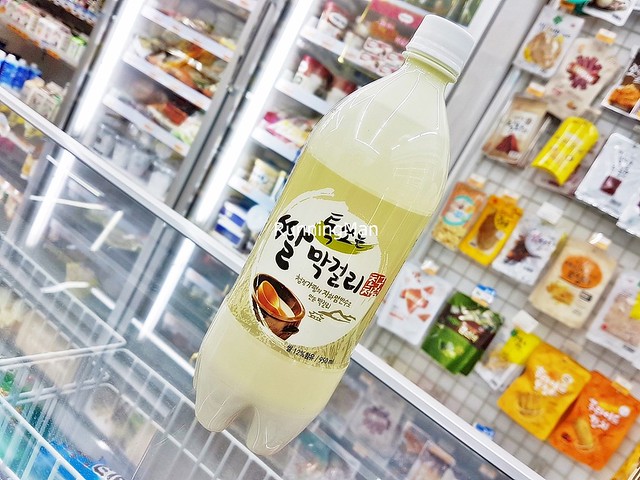 |
| Makgeolli / Rice Wine |
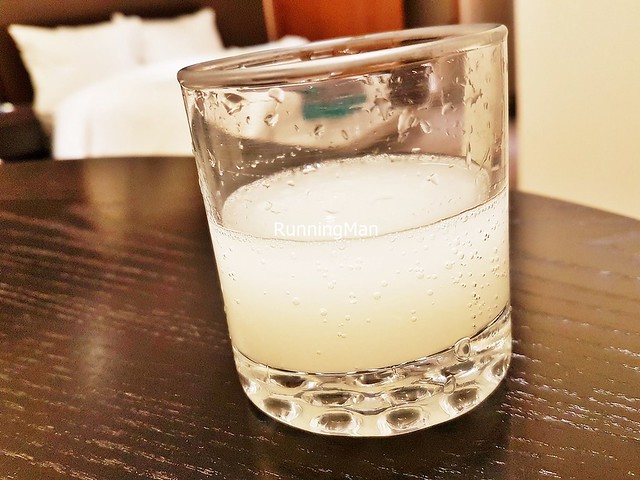 |
| Makgeolli / Rice Wine |
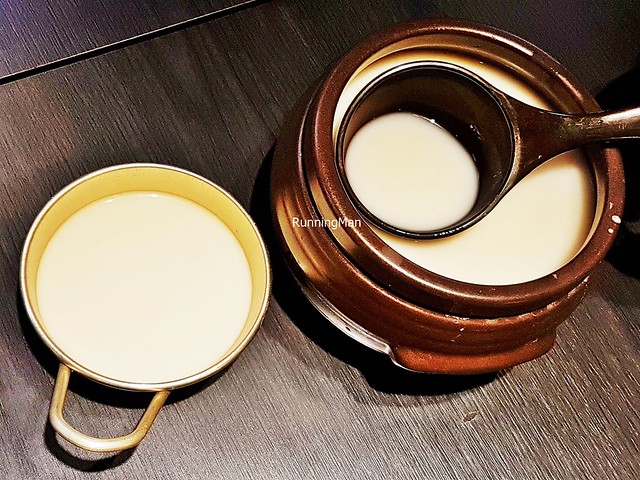 |
| Makgeolli / Rice Wine |
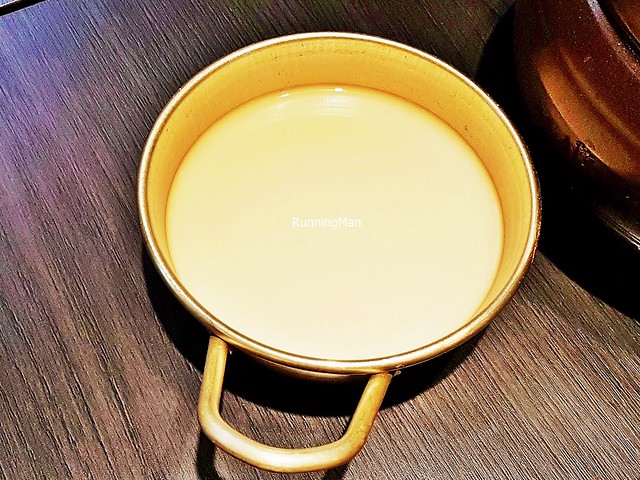 |
| Makgeolli / Rice Wine |
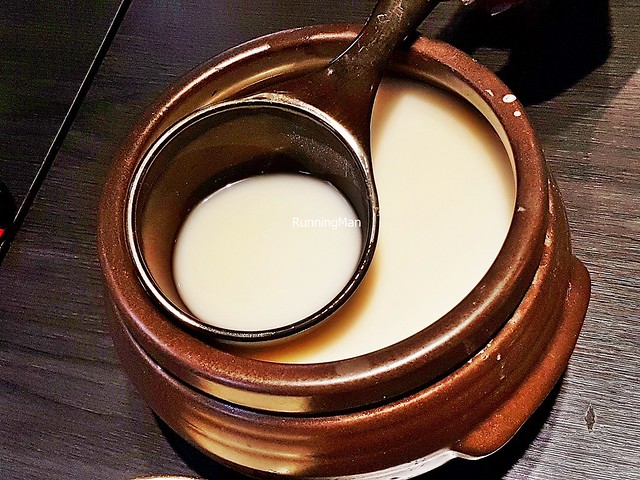 |
| Makgeolli / Rice Wine |
The Mandu / Dumpling is a common main dish / snack, and are usually filled with either minced meat (pork, beef), tofu beancurd, spinach, shiitake mushrooms, Kimchi Baechu / Kimchi Pickled Cabbage, scallions, or a combination of these ingredients. It can be boiled or steamed, grilled or fried, served dry or in a soup / broth. Has a tender soft juicy texture with robust meaty vegetal sweet savoury salty earthy flavour. If served in a soup / broth, the dish is called Manduguk, and usually features either a beef stock or anchovy stock, along with egg and seaweed. The most common versions include Mul Mandu / Boiled Pork Dumplings, Jjin Mandu / Steamed Pork Dumplings, and Kimchi Mandu / Steamed Kimchi Pork Dumplings.
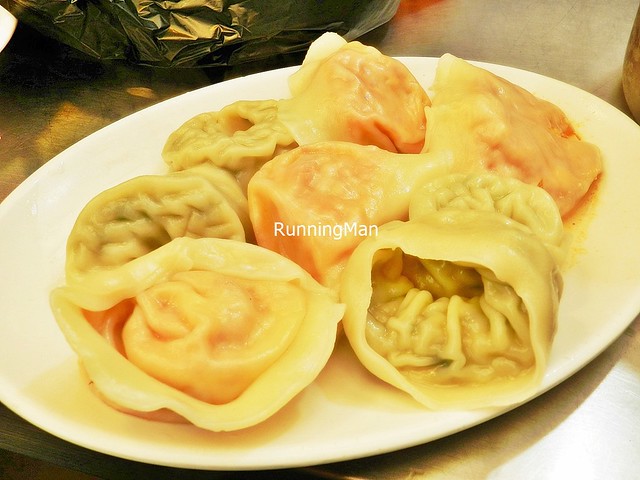 |
| Mandu / Dumpling |
 |
| Mandu / Dumpling |
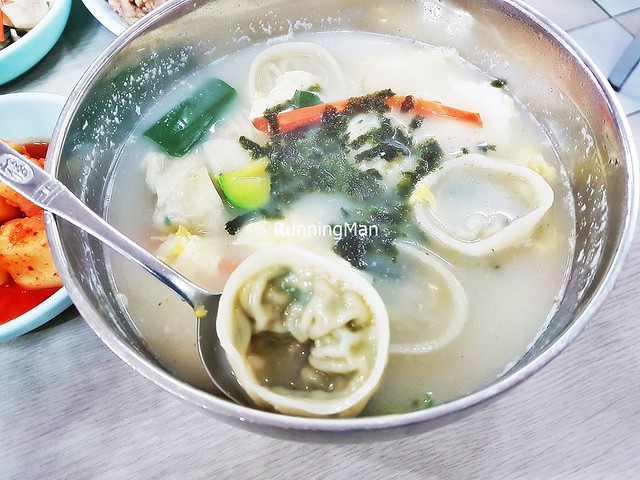 |
| Mandu / Dumpling |
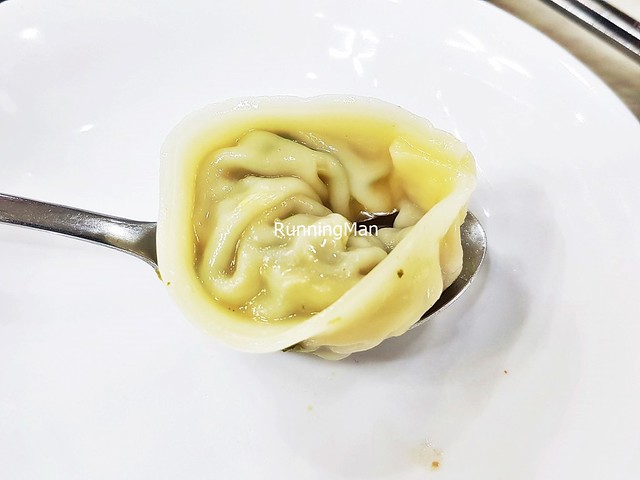 |
| Mandu / Dumpling |
Known for its high calcium and iodine content, the Miyeok Julgi Bokkeum / Sauteed Seaweed is a Banchan / side dish that's made with seaweed, onions, garlic, corn syrup / honey, soy sauce, salt, sesame seeds, and sesame oil. This is a rather uncommon dish though, as the chilled, crunchy, slippery texture, and sour bitter grassy taste does not exactly appeal to many.
 |
| Miyeok Julgi Bokkeum / Sauteed Seaweed |
 |
| Miyeok Julgi Bokkeum / Sauteed Seaweed |
 |
| Miyeok Julgi Bokkeum / Sauteed Seaweed |
The Pat Bing Su / Red Beans With Ice is a popular Korean shaved ice dessert, with the traditional version consisting of shaved ice, adzuki red beans, ground peanuts, Tteok / Dduk / rice cakes, and milk. Today, there are many different variations, and various ingredients can be added, such as fruits, cereal, flavoured syrups, yoghurt, ice cream, green tea, coffee, whipped cream, and more. I personally prefer the normal original version, which today leave out the Tteok / Dduk / rice cakes, for its sweet, earthy, creamy milky flavour. The shaved ice should be smooth and silky in texture, not grainy.
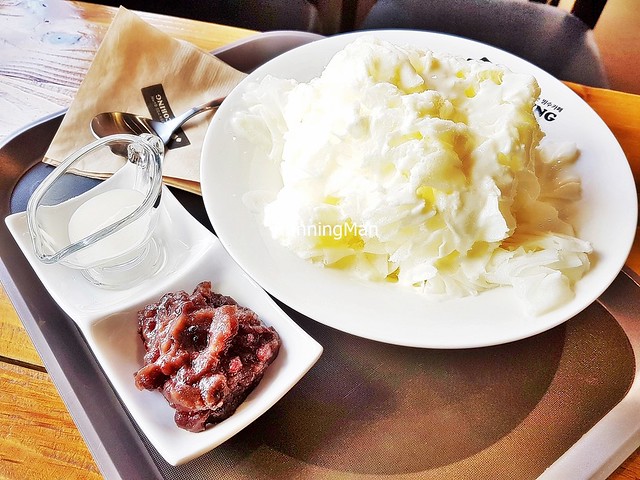 |
| Pat Bing Su / Red Beans With Ice |
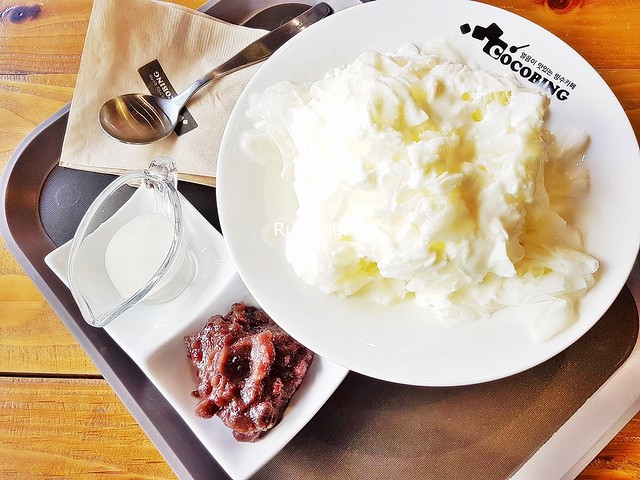 |
| Pat Bing Su / Red Beans With Ice |
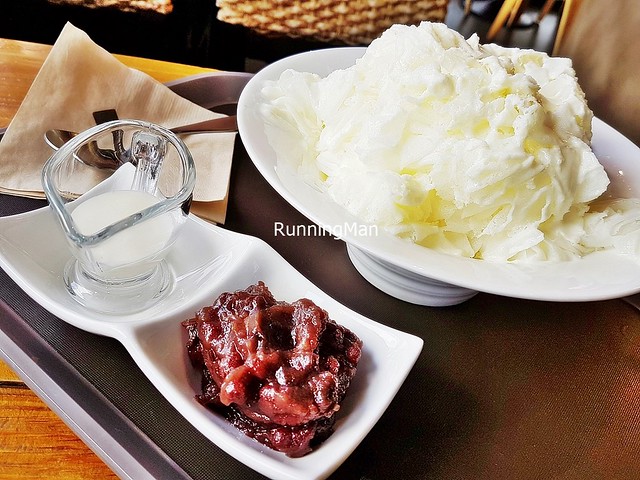 |
| Pat Bing Su / Red Beans With Ice |
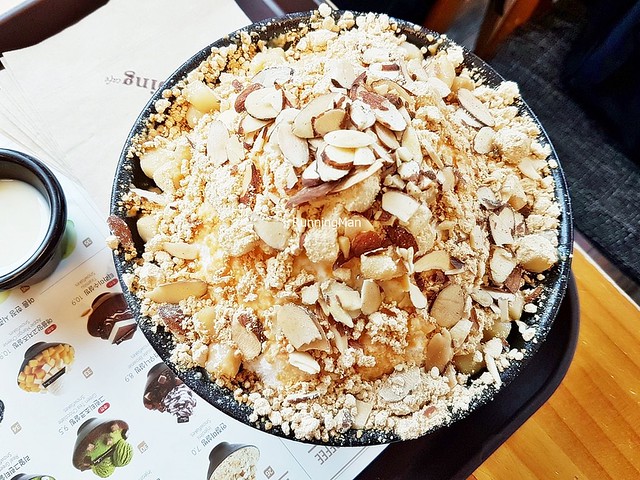 |
| Pat Bing Su / Red Beans With Ice |
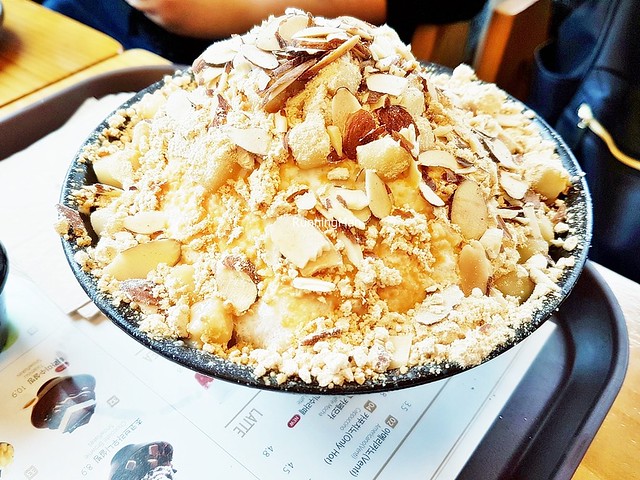 |
| Pat Bing Su / Red Beans With Ice |
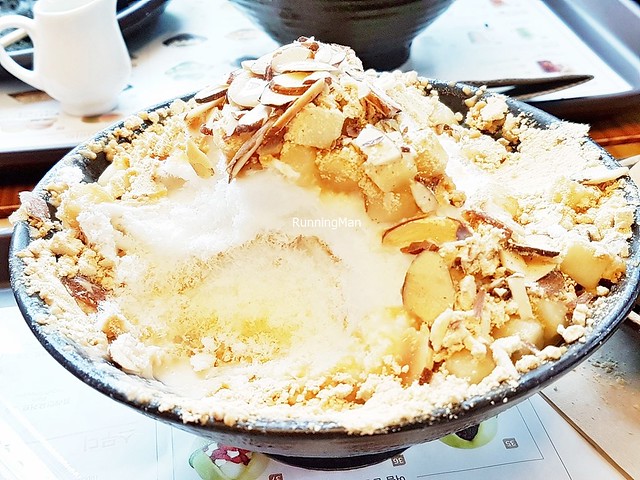 |
| Pat Bing Su / Red Beans With Ice |
The Rabokki / Ramen Noodles With Rice Cakes is a carbohydrate-laden, savoury spicy soup / broth dish, filled with Tteok / Dduk / rice cakes, instant ramen noodles, Kimchi Baechu / Kimchi Pickled Cabbage, eggs, sliced pork, onions, and scallions. This large main dish is suitable for sharing, and makes for a perfect meal on a cold day!
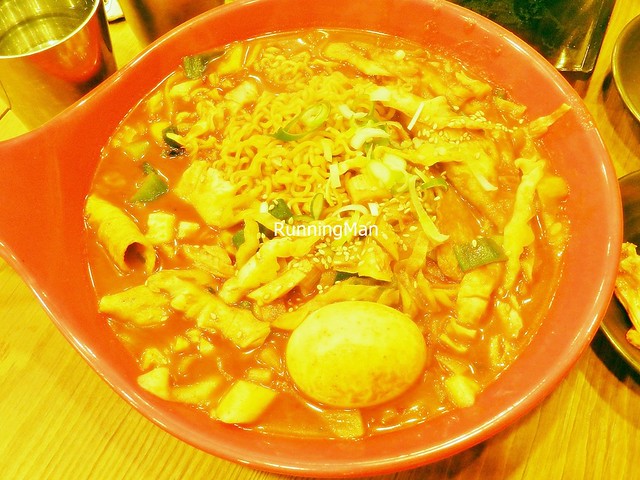 |
| Rabokki / Ramen Noodles With Rice Cakes |
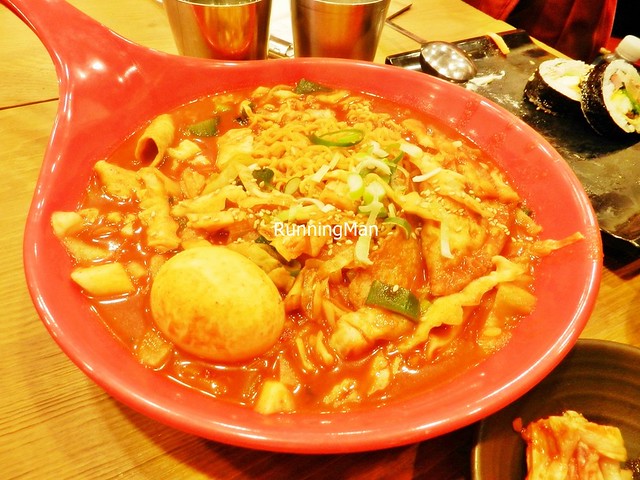 |
| Rabokki / Ramen Noodles With Rice Cakes |
The Samgyetang / Ginseng Chicken Soup, also known as Samgae-Tang, consists of a whole, young chicken, stuffed with glutinous rice, garlic, Korean ginseng herbs, water chestnut, jujube / red dates, onions, and scallions, in a thin, clear, but savoury sweet chicken soup / broth. The chicken meat attains a tender, fall off the bone texture, with a savoury sweet herbal taste. This hot soup / broth is a main dish, traditionally eaten on the 3 hottest days of the year.
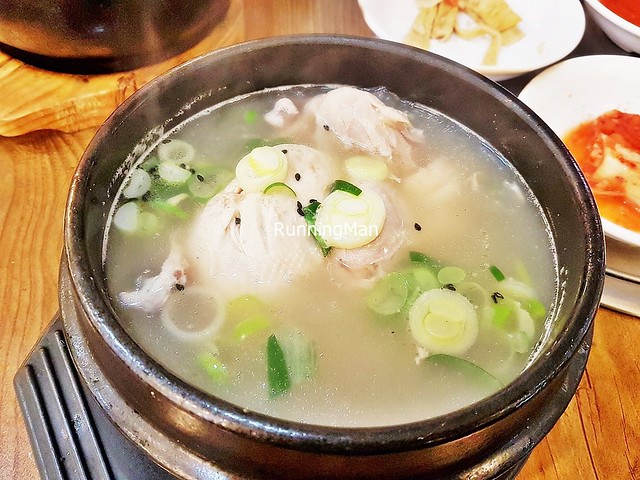 |
| Samgyetang / Ginseng Chicken Soup |
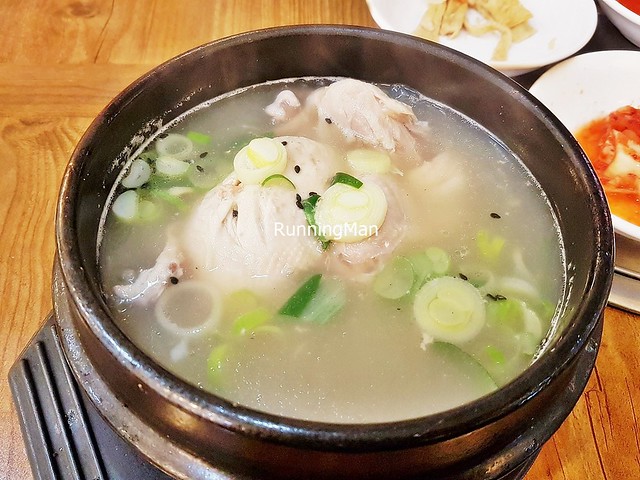 |
| Samgyetang / Ginseng Chicken Soup |
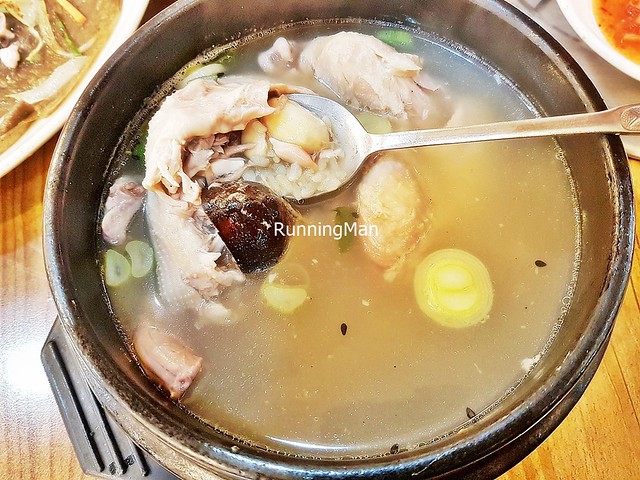 |
| Samgyetang / Ginseng Chicken Soup |
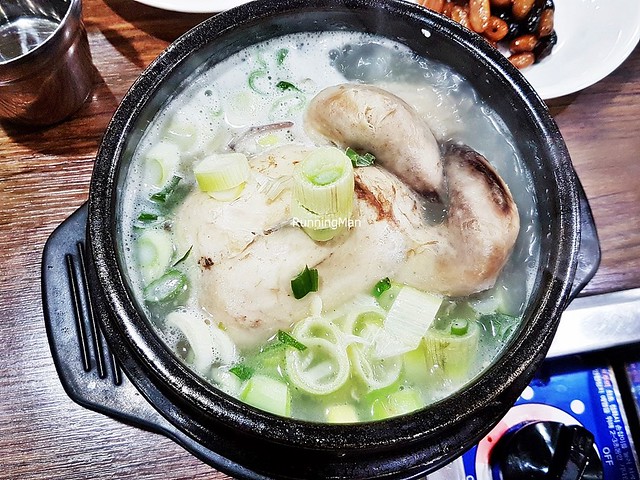 |
| Samgyetang / Ginseng Chicken Soup |
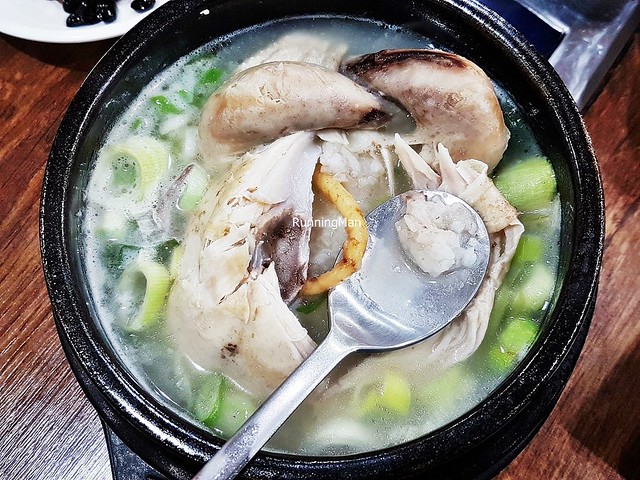 |
| Samgyetang / Ginseng Chicken Soup |
The Sesongyi-Guyi / Sauteed King Oyster Mushrooms is a Banchan / side dish, made with thinly sliced king oyster mushrooms, spinach, carrots, scallions, salt, and sesame oil. Served chilled, the earthy freshness of this pairs great with white rice.
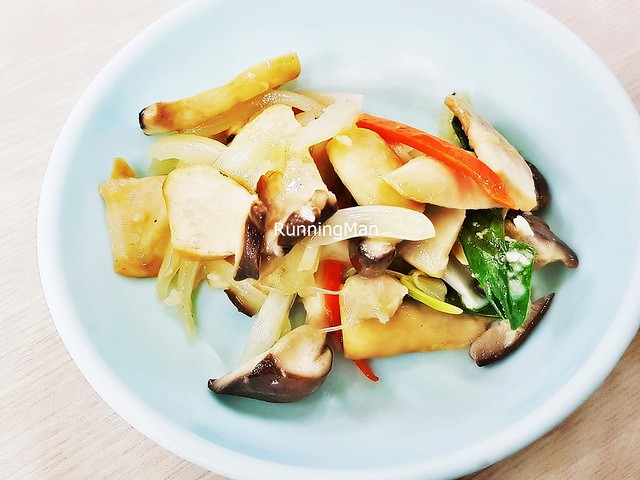 |
| Sesongyi-Guyi / Sauteed King Oyster Mushrooms |
The Sigeumchi Namul / Boiled Spinach is a common Banchan / side dish, featuring blanched spinach, seasoned with salt, garlic, soy sauce, sesame seeds, sesame oil, and sometimes chili. This simple dish is often served as part of a meal, and the chilled, refreshing texture it has contrasts nicely with the more heavily seasoned Korean main dishes.
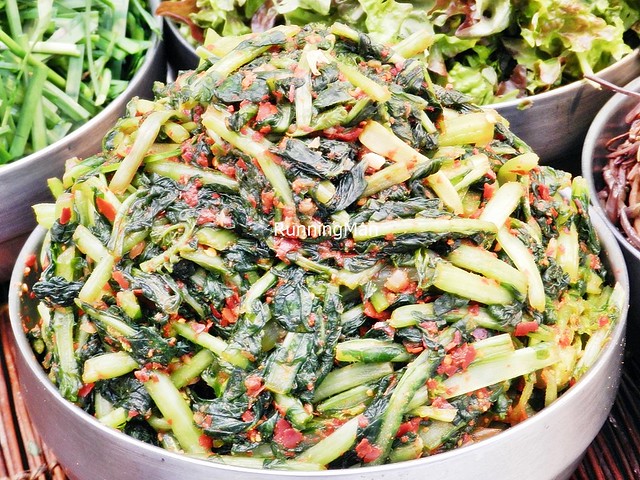 |
| Sigeumchi Namul / Boiled Spinach |
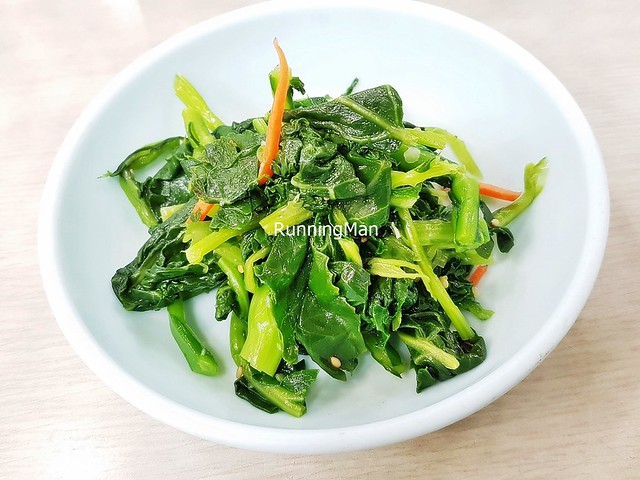 |
| Sigeumchi Namul / Boiled Spinach |
The Soju is an alcoholic beverage, whose base is made by distilling water together with either white rice, wheat, barley, potato, sweet potato, or tapioca, although modern versions also use fruit. Typically consumed neat, this clear, smooth drink is usually sour sweet in taste, with a lingering alcohol burn. The Soju Lotte Chilsung Chum-Churum is made with alkaline mineral water, along with sugar, corn syrup, and white rice, with a pleasantly strong body.
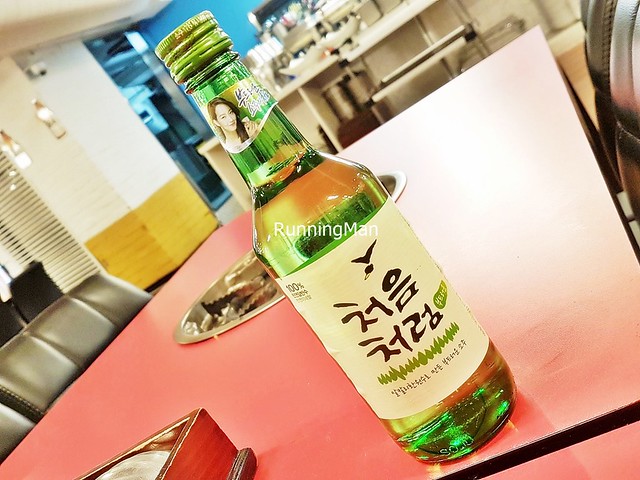 |
| Soju Lotte Chilsung Chum-Churum |
The Soondae Chapssal / Blood Sausage With Glutinous Rice is among the more unusual food around. It's made with cow or pig intestines, stuffed with sweet sticky glutinous rice that has been soaked in cow or pig blood. Boiled and then served chilled, it has a slightly chewy, sticky texture, with a pleasant mineral, earthy taste complemented by the sweetness of the stuffing.
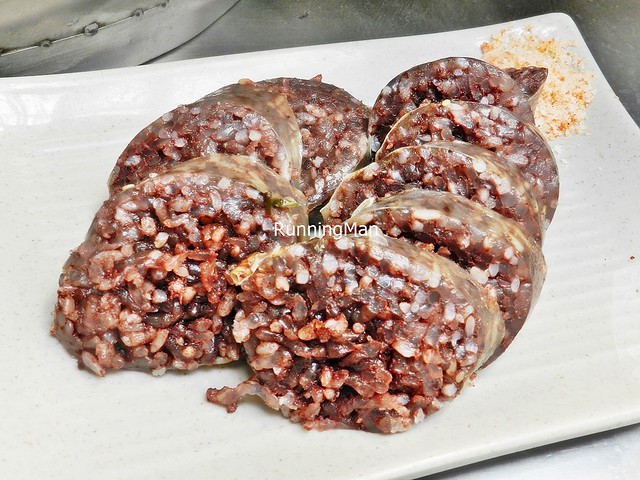 |
| Soondae Chapssal / Blood Sausage With Glutinous Rice |
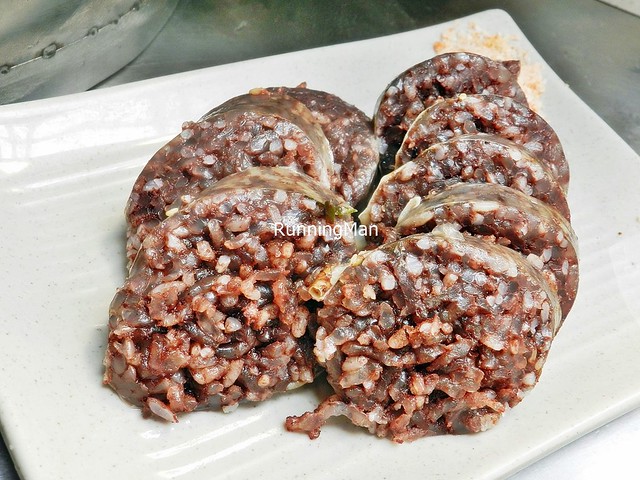 |
| Soondae Chapssal / Blood Sausage With Glutinous Rice |
 |
| Soondae Chapssal / Blood Sausage With Glutinous Rice |
The Soondubu Jjigae / Silken Tofu Stew, also known as Sundubu Jjigae, is a savoury spicy, comforting main dish, made with soft silken tofu / beancurd, mushrooms, onions, shrimp / prawns, clams or mussles, Kimchi Baechu / Kimchi Pickled Cabbage, beef or pork, and eggs, in a soup / broth made from water, soy sauce, daikon radish, onions, garlic, salt, sugar, sesame oil, gochujang / fermented red chili paste, and seaweed. It's served while still bubbling vigorously.
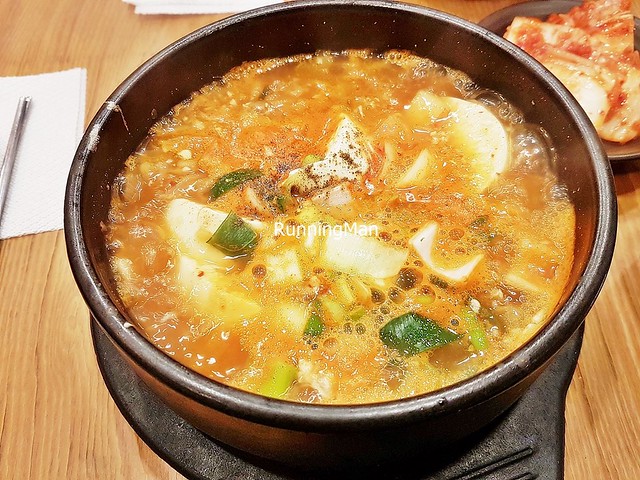 |
| Soondubu Jjigae / Silken Tofu Stew |
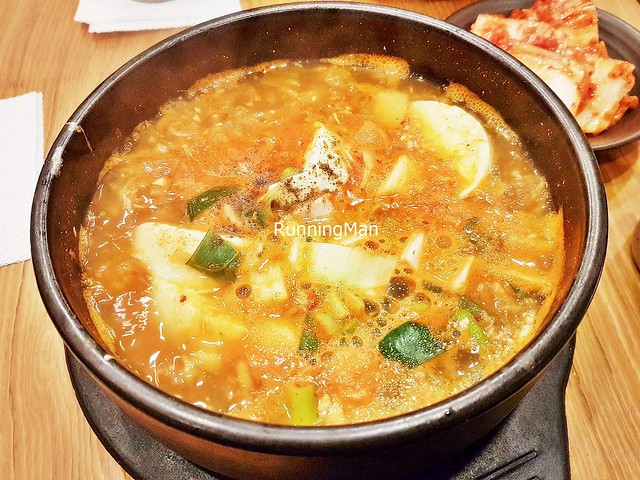 |
| Soondubu Jjigae / Silken Tofu Stew |
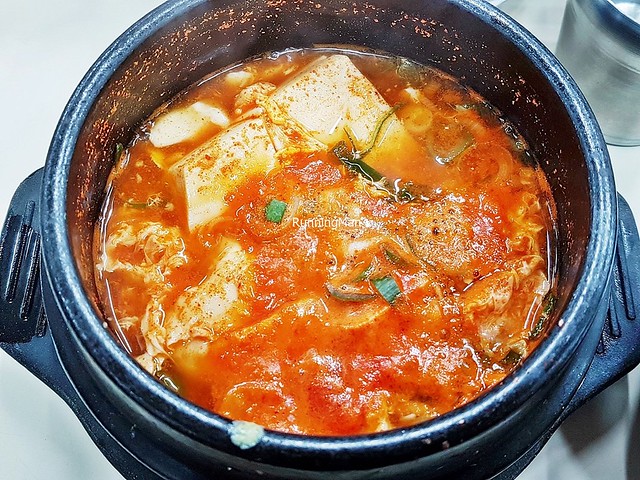 |
| Soondubu Jjigae / Silken Tofu Stew |
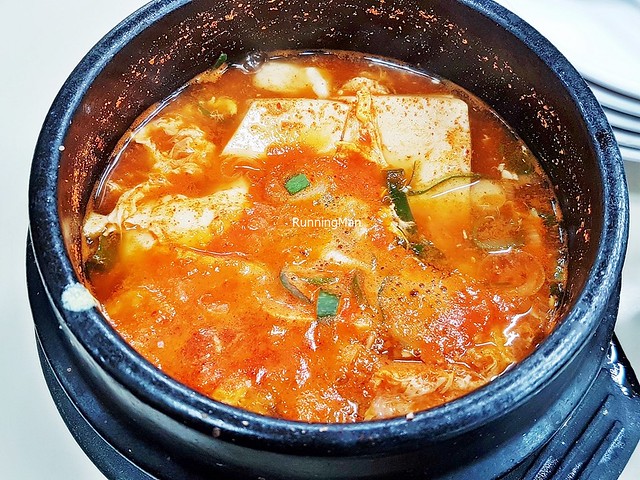 |
| Soondubu Jjigae / Silken Tofu Stew |
 |
| Soondubu Jjigae / Silken Tofu Stew |
The Sosiji Saengseon Keikeu / Sausage With Fish Cake is a Banchan / side dish, made with sliced chicken hot dogs / sausages, fish cakes, and flavoured with gochujang / fermented red chili paste. It's served chilled.
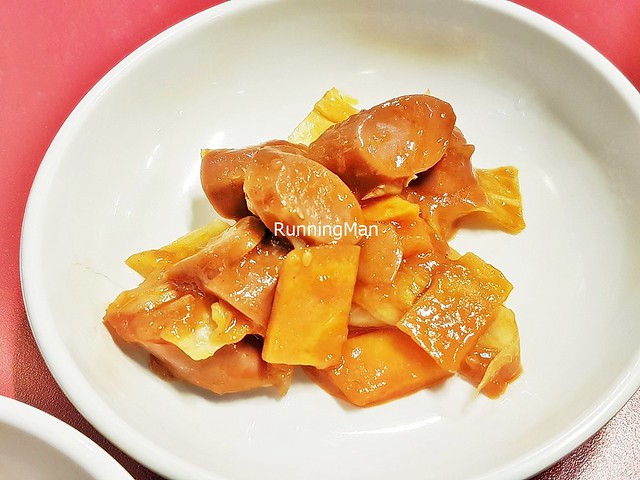 |
| Sosiji Saengseon Keikeu / Sausage With Fish Cake |
A bowl of Ssalbap / Steamed White Rice typically accompanies any meal in Seoul, South Korea. The texture is sticky but not clumpy, with a light fragrant aroma, and grainy sweet flavour. Some variations may include a dressing of foxtail millet or dried shredded seaweed.
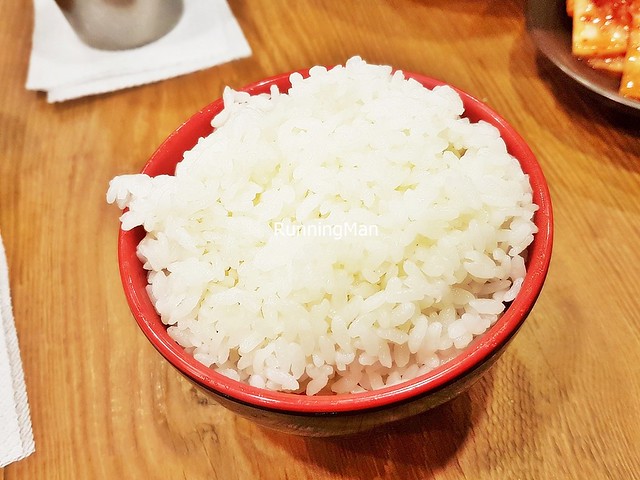 |
| Ssalbap / Steamed White Rice |
 |
| Ssalbap / Steamed White Rice |
The Tornado Twist Potato is a popular street food sold by street vendors, made by thinly slicing a potato in 1 continuous, unbroken chain, resulting in its spiral shape. Deep fried on skewers, it can then be further seasoned with a seasoning or sauce of your choice, with the default being just salt.
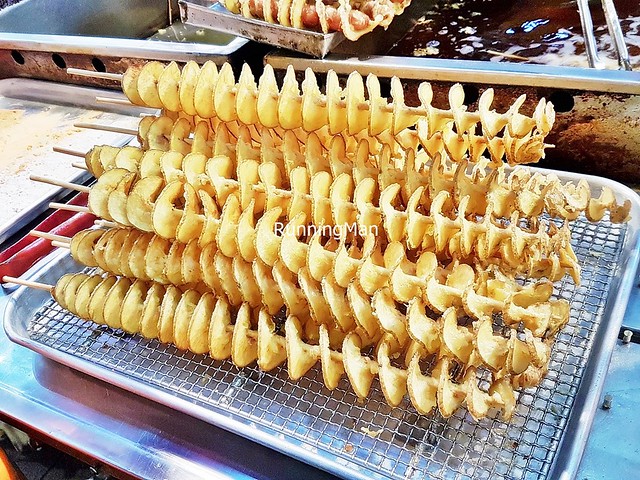 |
| Tornado Twist Potato |
 |
| Tornado Twist Potato |
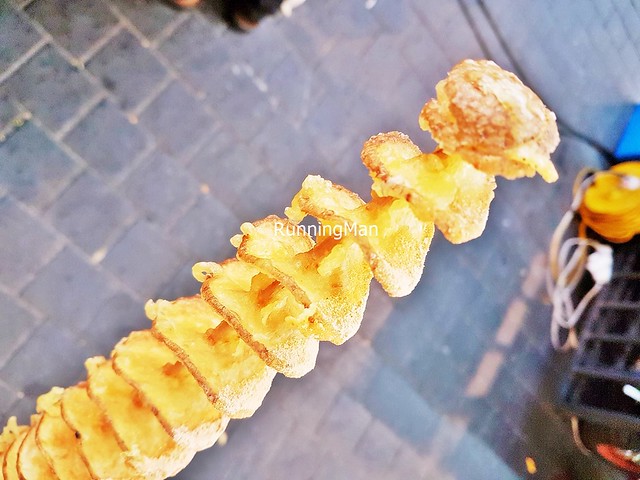 |
| Tornado Twist Potato |
The Tteokbokki / Ddukbokki / Rice Cakes is a common and popular Banchan / side dish, also often sold along the streets as a snack. Made by boiling then stir-frying Tteok / Dduk / rice cakes, which are soft, chewy, but tasteless, glutinous rice cake shaped like round tubes, in a sweet, savoury, spicy gravy of water and gochujang / fermented red chili paste, along with fish cakes, onions, salt, sugar, garlic, and scallions. Sometimes, pork or eggs are added. Tteokbokki / Ddukbokki / Rice Cakes is sometimes used as a base ingredient, and incorporated into other Korean main dishes. There are also many variations of it available.
 |
| Tteokbokki / Ddukbokki / Rice Cakes |
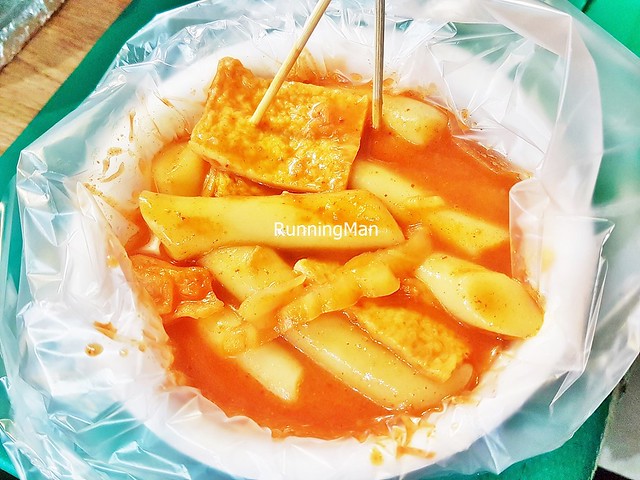 |
| Tteokbokki / Ddukbokki / Rice Cakes |
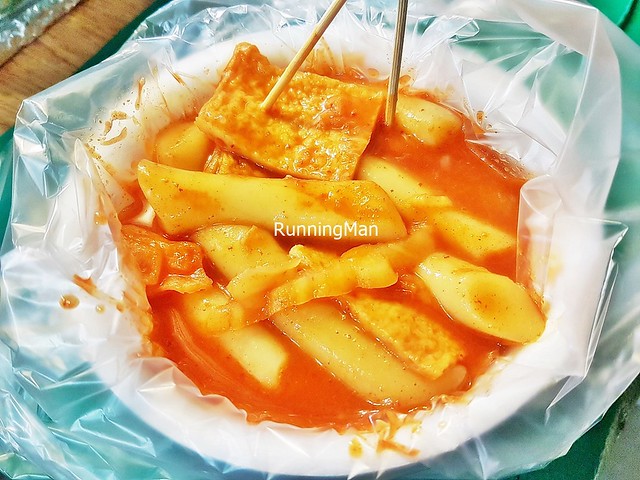 |
| Tteokbokki / Ddukbokki / Rice Cakes |
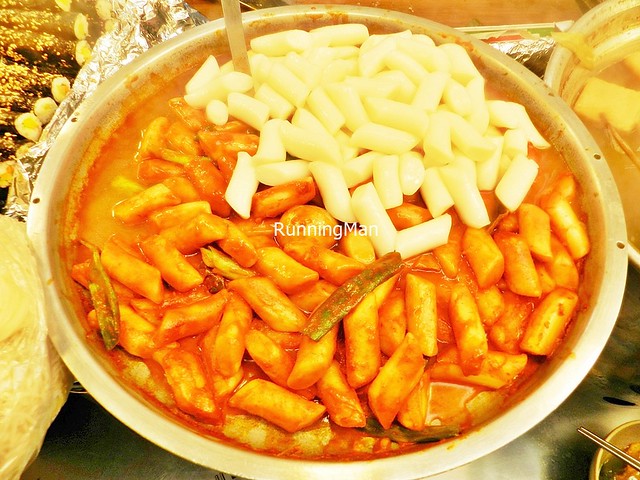 |
| Tteokbokki / Ddukbokki / Rice Cakes |
The Ttukbaegi Gyeran Jjim / Steamed Egg In Pot is a simple but comforting Banchan / side dish, consisting of whisked chicken eggs seasoned with garlic, aekjeot / fish sauce, chicken stock, water, and sesame oil, then steamed till soft and fluffy in an earthenware pot, garnished with scallions. Love the light eggy savoury salty sweet flavour, which pairs well with the more heavily seasoned main dishes.
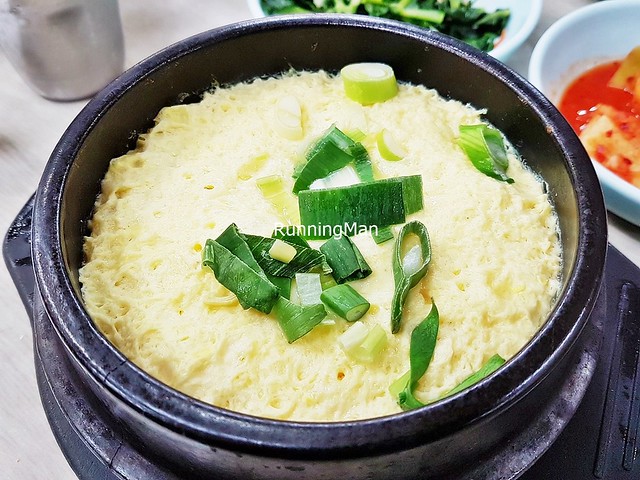 |
| Ttukbaegi Gyeran Jjim / Steamed Egg In Pot |
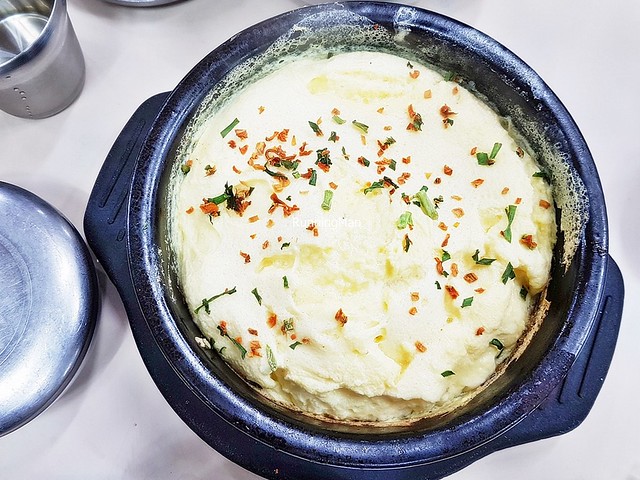 |
| Ttukbaegi Gyeran Jjim / Steamed Egg In Pot |
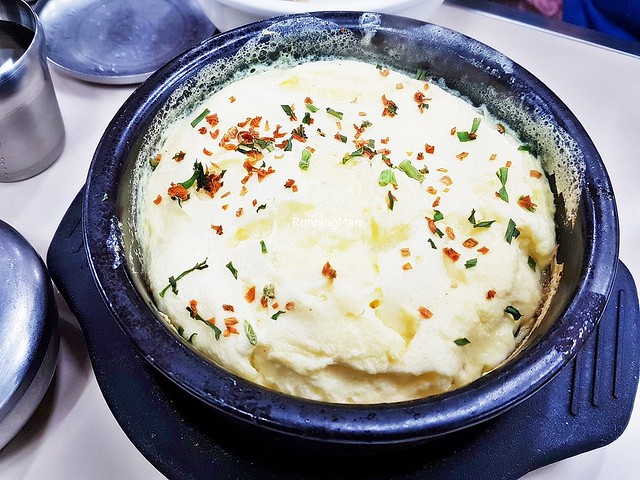 |
| Ttukbaegi Gyeran Jjim / Steamed Egg In Pot |
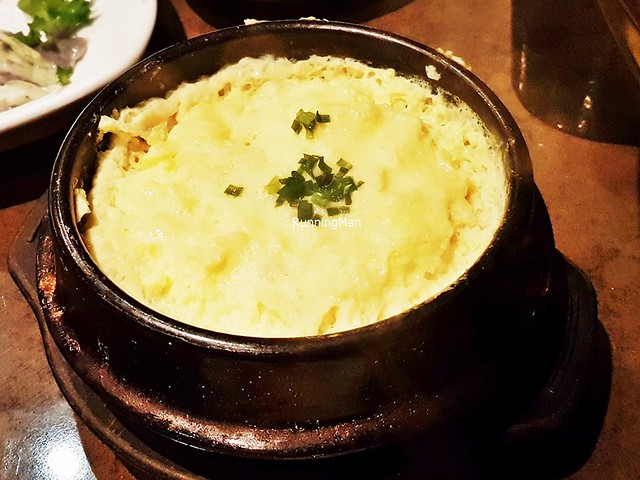 |
| Ttukbaegi Gyeran Jjim / Steamed Egg In Pot |
The beauty of Huraideu Chikin / Fried Chicken is the tender, moist chicken meat which comes easily off the bone, is savoury sweet in taste, and yet has a crisp, non-greasy skin that is savoury salty and crunches in the mouth satisfyingly. This is normally achieved by flash frying the battered chicken, letting it rest awhile, and then frying it again (double frying technique). This main dish is often served along with refreshing types of Banchan / side dishes, and is eaten with the hands.
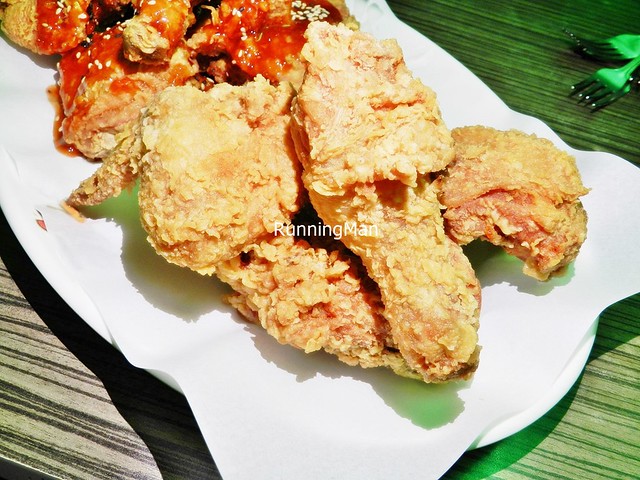 |
| Huraideu Chikin / Fried Chicken |
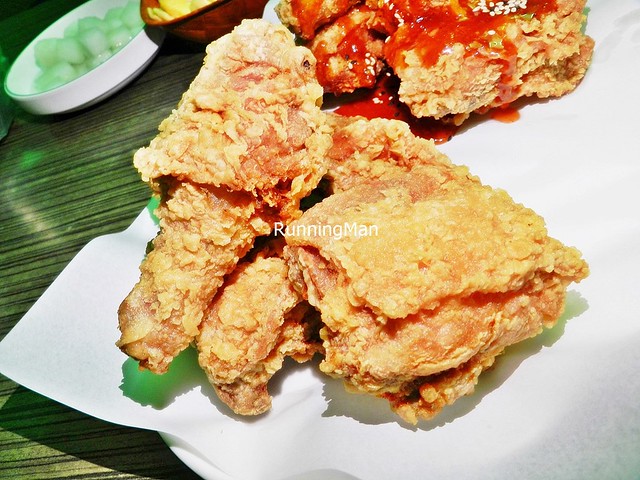 |
| Huraideu Chikin / Fried Chicken |
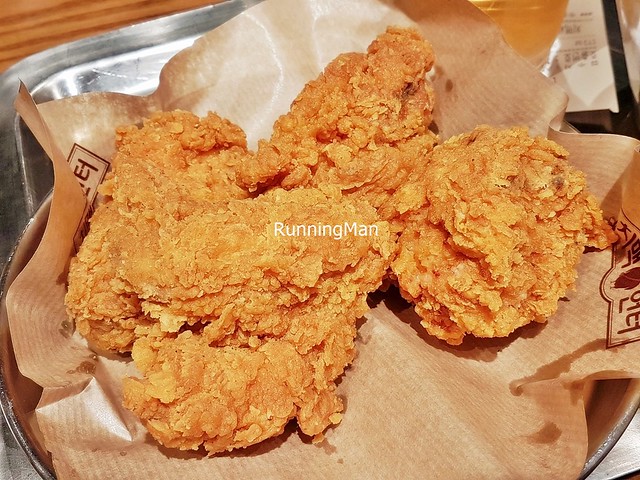 |
| Huraideu Chikin / Fried Chicken |
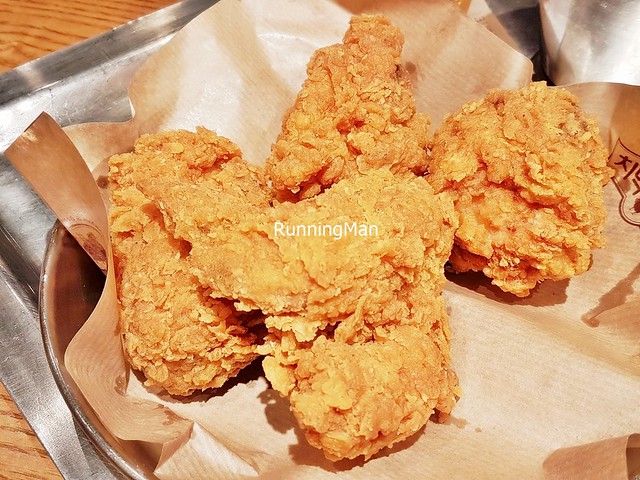 |
| Huraideu Chikin / Fried Chicken |
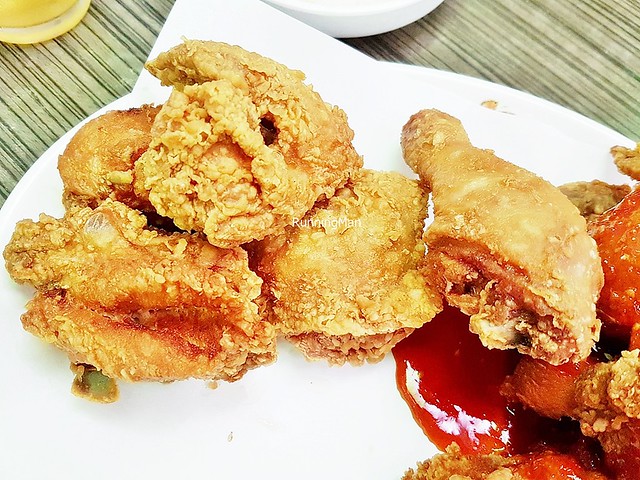 |
| Huraideu Chikin / Fried Chicken |
Using the same double frying method, the Yangnyeom Tongdak / Sweet & Spicy Chicken is coated in a thick, sweet spicy gravy, made from tomato ketchup, rice syrup or corn syrup, white vinegar, salt, white sugar, gochujang / fermented red chili paste, garlic, and sesame oil. Has a tender moist sticky texture, the chicken meat pulling easily off the bone, with bold savoury sweet spicy flavour. Just as delicious, but a lot more messy!
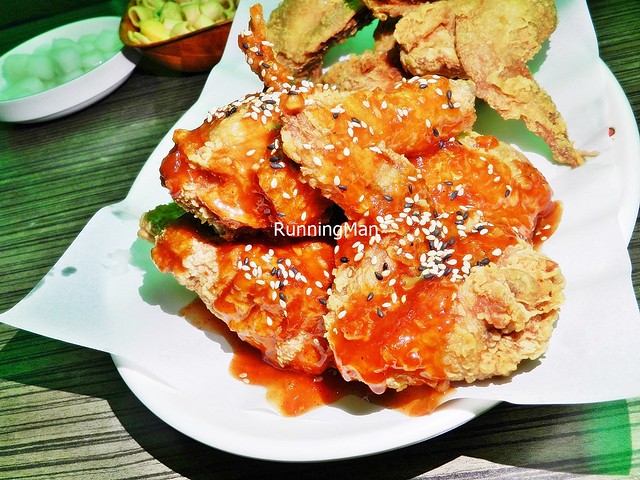 |
| Yangnyeom Tongdak / Sweet & Spicy Chicken |
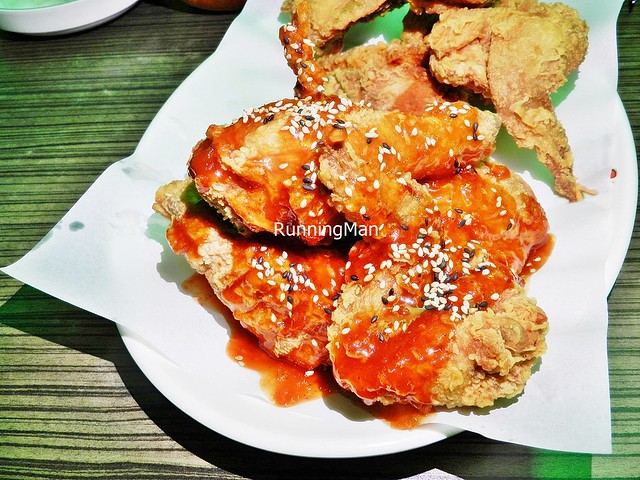 |
| Yangnyeom Tongdak / Sweet & Spicy Chicken |
 |
| Yangnyeom Tongdak / Sweet & Spicy Chicken |
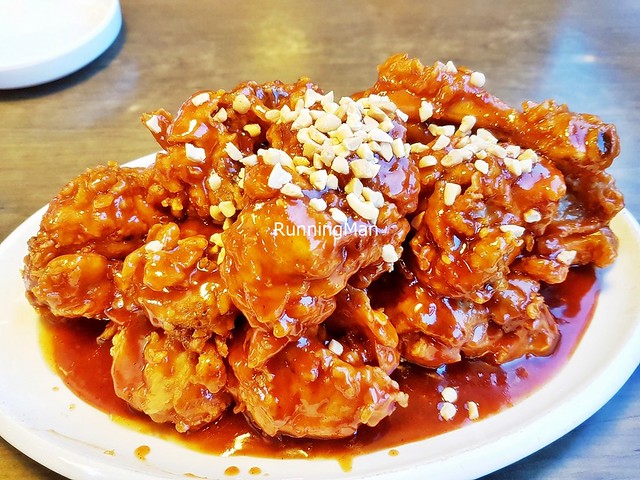 |
| Yangnyeom Tongdak / Sweet & Spicy Chicken |
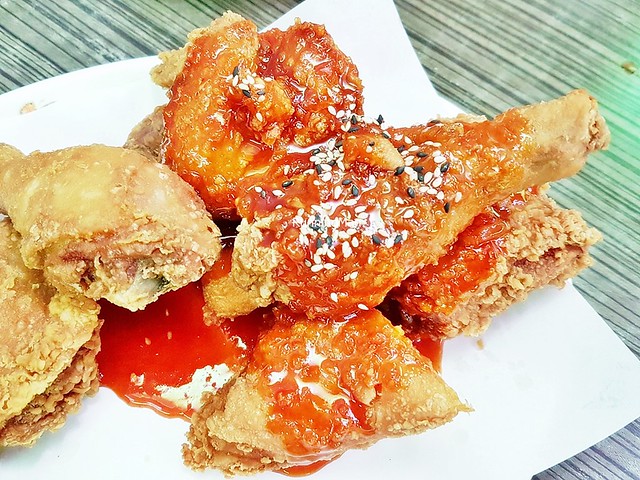 |
| Yangnyeom Tongdak / Sweet & Spicy Chicken |
.....


CONVERSATION